I’m very excited to finally bring you this list of Munich WWII sites—a list I’ve been compiling for as long as I can remember. I spend more time in Munich each year than I do any other city (besides the one I live in) and to this I owe the credit of my interest in World War II. It was here in Munich (specifically, after my first trip to Dachau in 2012) where my, let’s call it an obsession, with this time period really started to develop.
And that’s simply because there are so many Munich World War II sites to still see and explore. Munich, Germany (tragedy that it is) is the city that started it all. It was here where Adolf Hitler rose to power, where the Nazi Party was formed, where the first concentration camp was erected. Munich was the birthplace, headquarters, and command center of the Third Reich.
In other words, you won’t find any shortage of Munich WWII sites when you get here. This post highlights some of the many worthwhile spots you shouldn’t miss on your next trip to Bavaria’s capital.
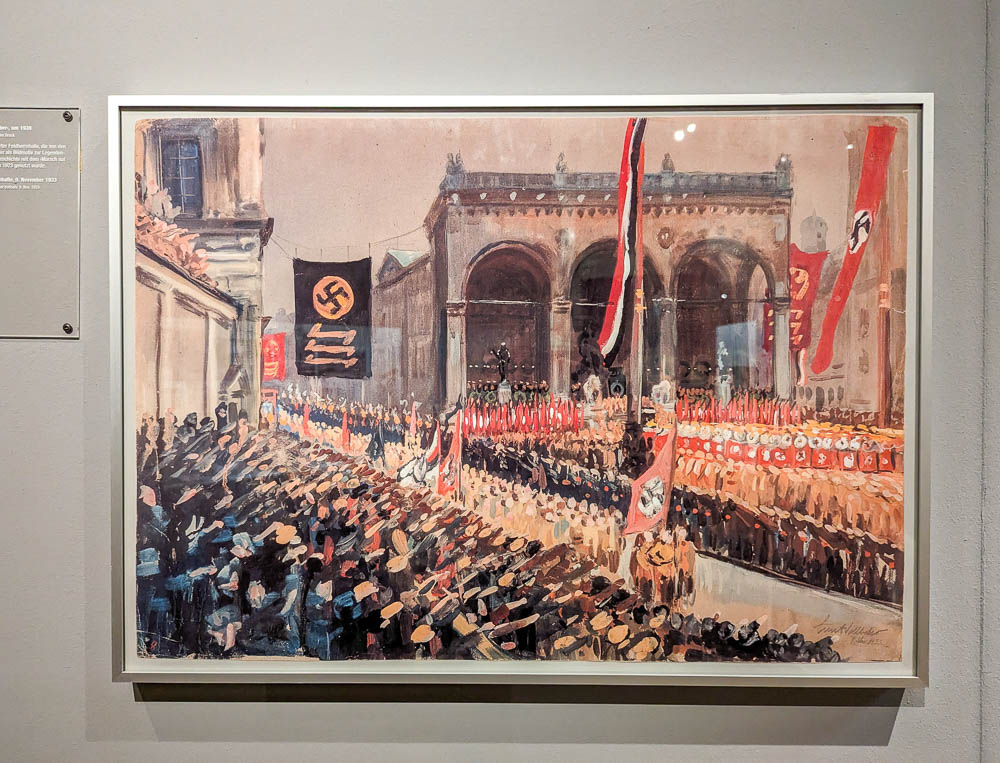
World War II in Munich, Germany
A lot happened in Munich during the Second World War, to say the least. If you want to know all about it, I highly recommend reading one of the books at the bottom of this post. For now, I’m going to (significantly) abbreviate what happened here and mention just the key events you’ll hear/read the most about.
Rise of Adolf Hitler
Hitler had been living in Munich since 1913 when he joined and “rebranded” the NSDAP here in 1920—the National Socialist German Worker’s Party, aka the Nazi Party.
Catalyzed by the Great Depression and a rhetoric based on conspiracy theories and fanaticism, Hitler’s power and influence grew at an alarming rate. He ultimately became Chancellor of Germany in 1933. When Germany’s President Paul von Hindenburg died later that year, Hitler took over his position and appointed himself Führer—Germany’s new supreme leader.
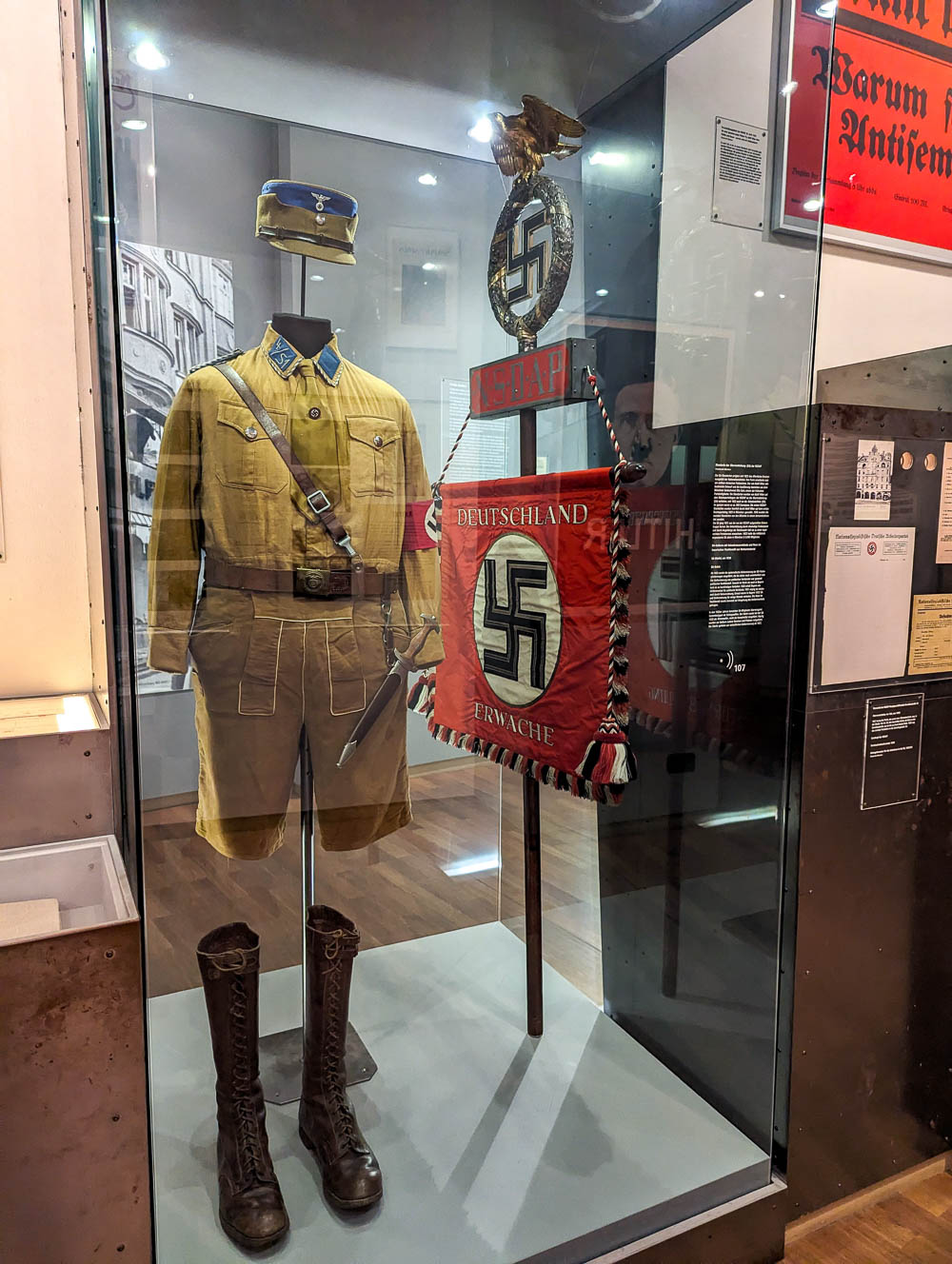
Birthplace of the Nazi Party / Home of the Third Reich
What would ultimately become the Nazi Party started here inside the beer halls in Munich. The NSDAP continued to grow and evolve, as did its influence and power, until it became the largest political party in Germany. And we all know what happened next.
Until the end of the war, the Nazi Party called the Bavarian capital home. Munich was the “Capital of the Movement,” as they called it. Some of the Party’s most revered buildings and memorials were located here, as were their central offices (since they ruled mostly from Berlin and Berchtesgaden later on).
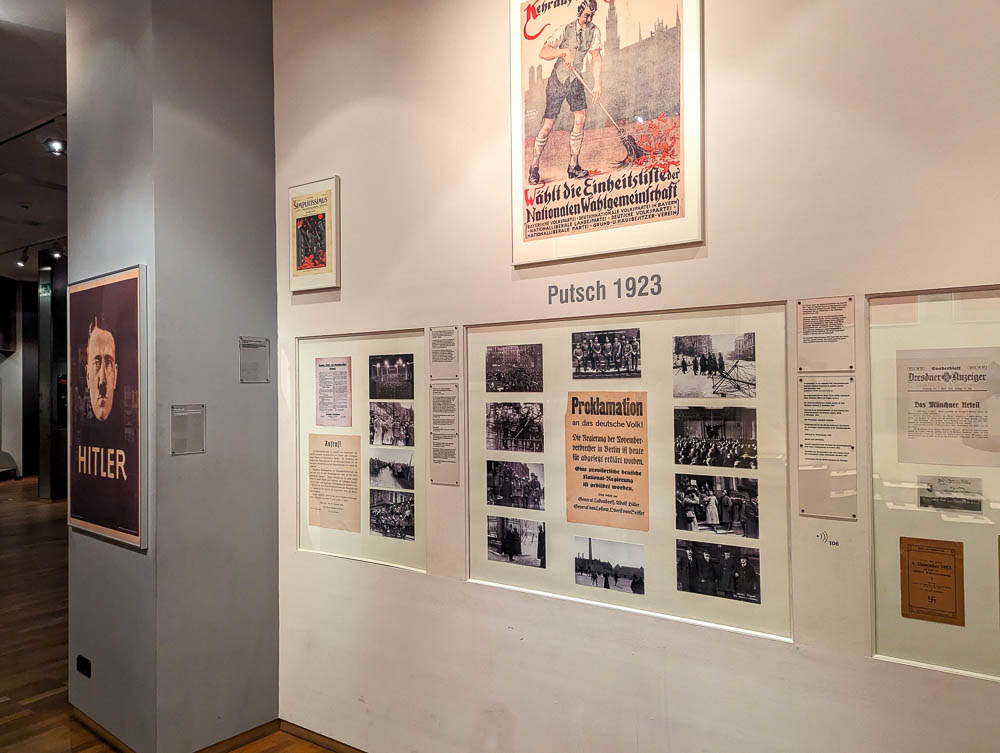
Beer Hall Putsch
The Beer Hall Putsch (November 8-9, 1923) was Hitler’s violent attempt to overthrow the current government, named for the location from which it began (the Bürgerbräukeller beer hall). Twenty people were killed (16 Nazis, 4 police officers) and Hitler was sentenced to five years in prison. He served only 8 months before being released. While locked up, he wrote Mein Kampf.
The first concentration camp
On March 22, 1933, the Nazi Party opened its first concentration camp in nearby Dachau. Originally intended for political prisoners, the Nazis ultimately imprisoned almost 200,000 people at Dachau that also included Jews, homosexuals, communists, Catholic priests, and more. Despite not being a “death camp,” an estimated 41,500 people died/were killed at Dachau before American troops liberated it in April 1945.
Dachau was the Nazi’s crown jewel, essentially, and they used it as the model for all future camps they built—estimated to be around 44,000. (Yes, you read that right.) They also used Dachau as a training ground for up-and-coming commandants and guards.
You can still visit Dachau Concentration Camp. Click on that link for my full guide.
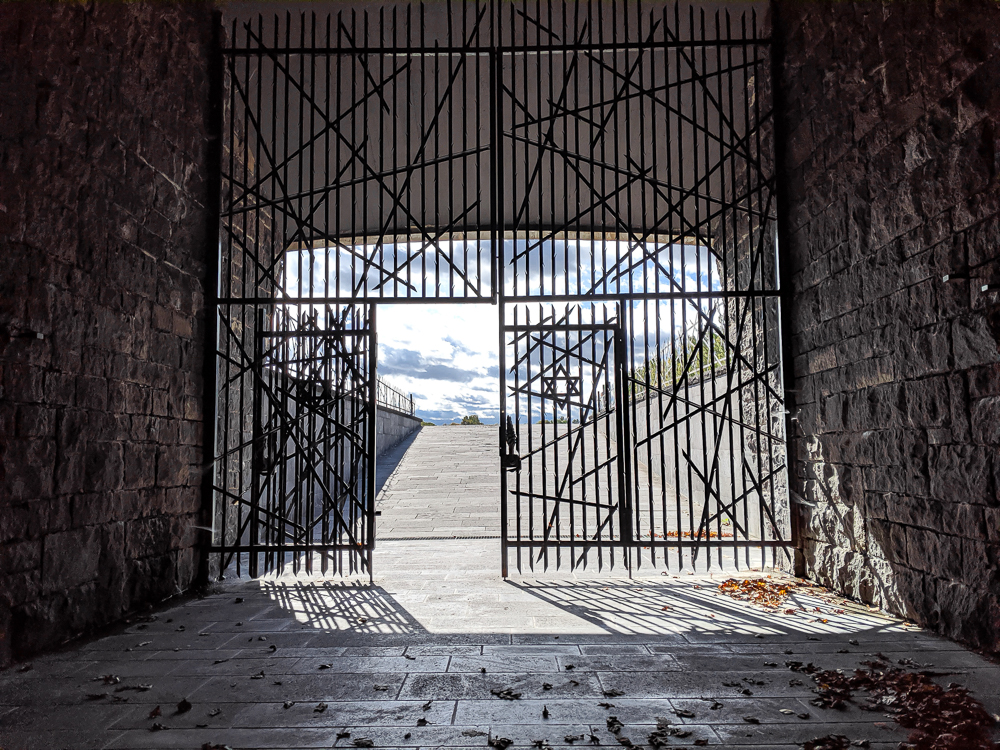
Assassination attempt
On November 8, 1939, a man named Georg Elser executed a plan to assassinate Hitler and whichever of his fellow high-ranking Nazis happened to be near him at the time. He planted and detonated a bomb under the podium where Hitler was giving speech at the Bürgerbräukeller to celebrate the Putsch’s anniversary.
Except, Hitler had moved the celebration up at the last minute and so left the beer hall earlier than planned. The bomb detonated just 13 minutes after he’d left. Eight (Nazi) bystanders were killed and dozens more injured. The Gestapo arrested, interrogated, beat, and tortured Elser for over a year.
They imprisoned him at Sachsenhausen concentration camp from 1941-1945, then transferred him to Dachau in April 1945. On April 5, with the Allies closing in, Hitler ordered Elser’s execution. On April 9, he was fatally shot and tossed into the crematorium at Dachau.
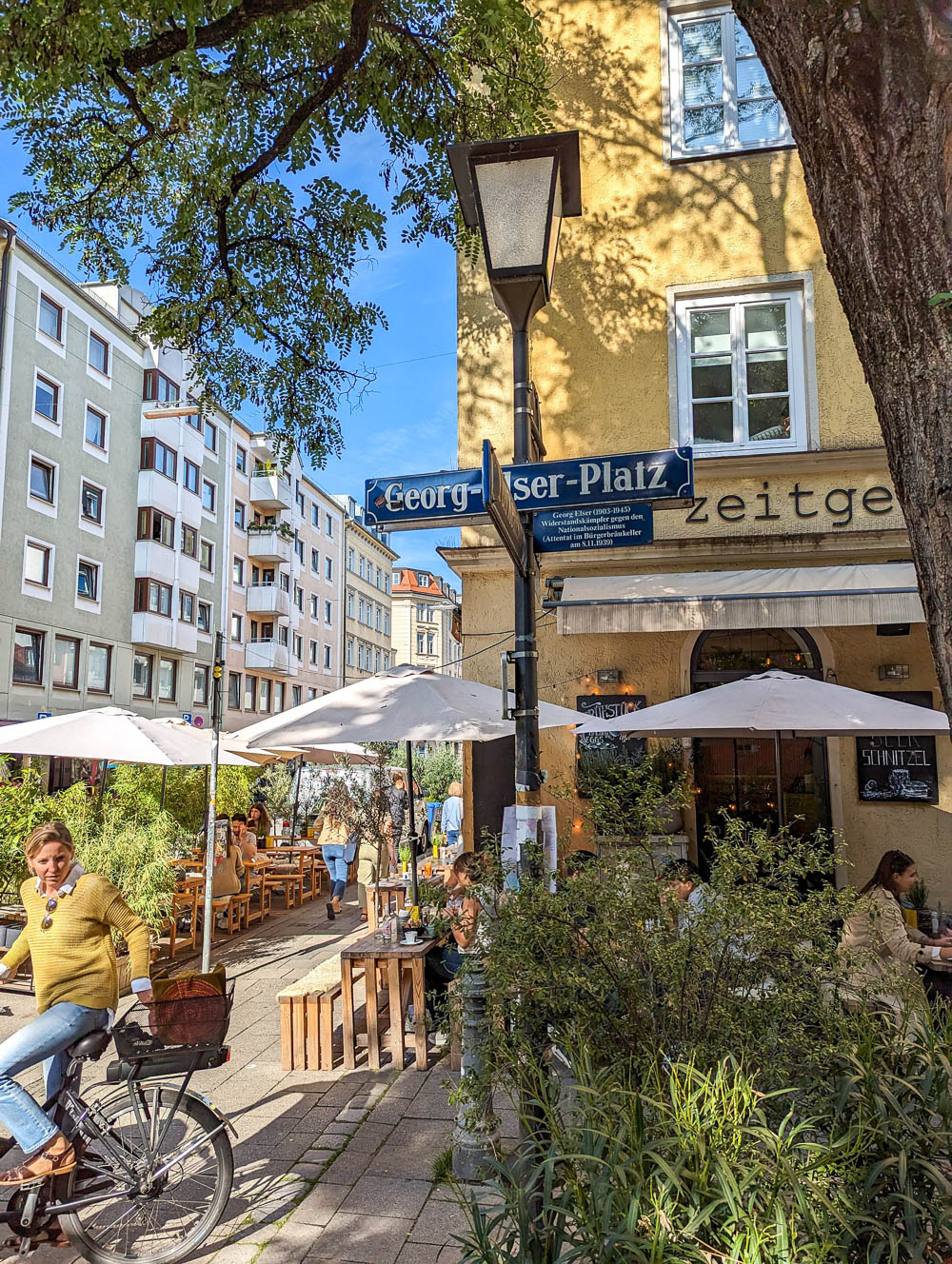
White Rose resistance group
One of the most famous resistance groups began here in Munich, formed by a group of students at a local university. Led by Hans and Sophie Scholl, they printed and distributed anti-Nazi pamphlets and were ultimately arrested for this. All were executed by guillotine shortly after.
This is a super brief summary, so please check out my full post on Munich’s White Rose movement here.
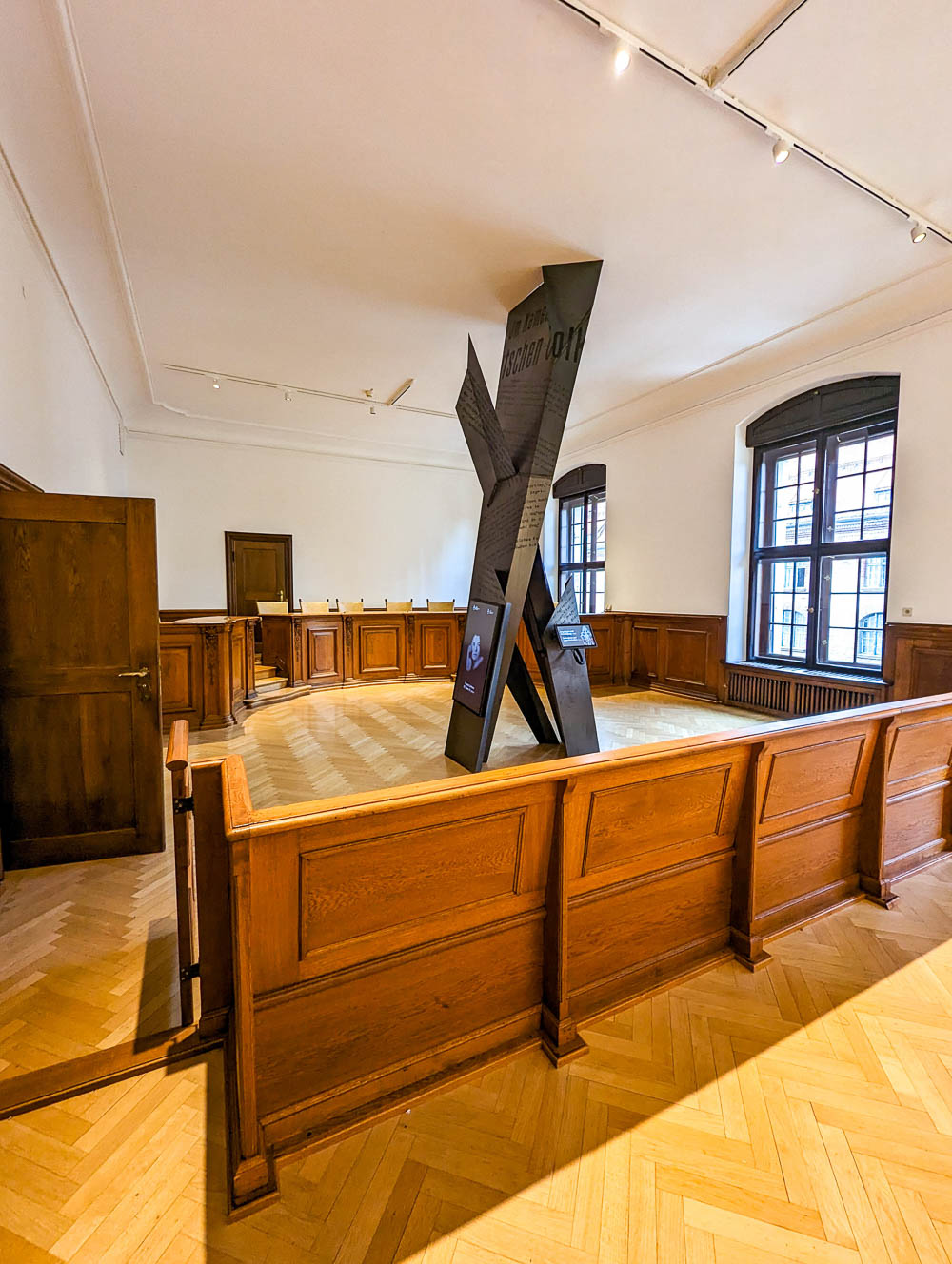
Bombing of Munich
In the final months of the European war, the British RAF and the US Air Force executed bombing raids on Munich. The majority of Nazi Party operations had moved to Berlin by now, but Munich being the “Capital of the Movement,” the raids served special propaganda purposes.
As a result of the 70+ bombing raids, more than 6,600 people were killed and much of the city was significantly damaged. Most of it was rebuilt after the war to pre-war specifications.
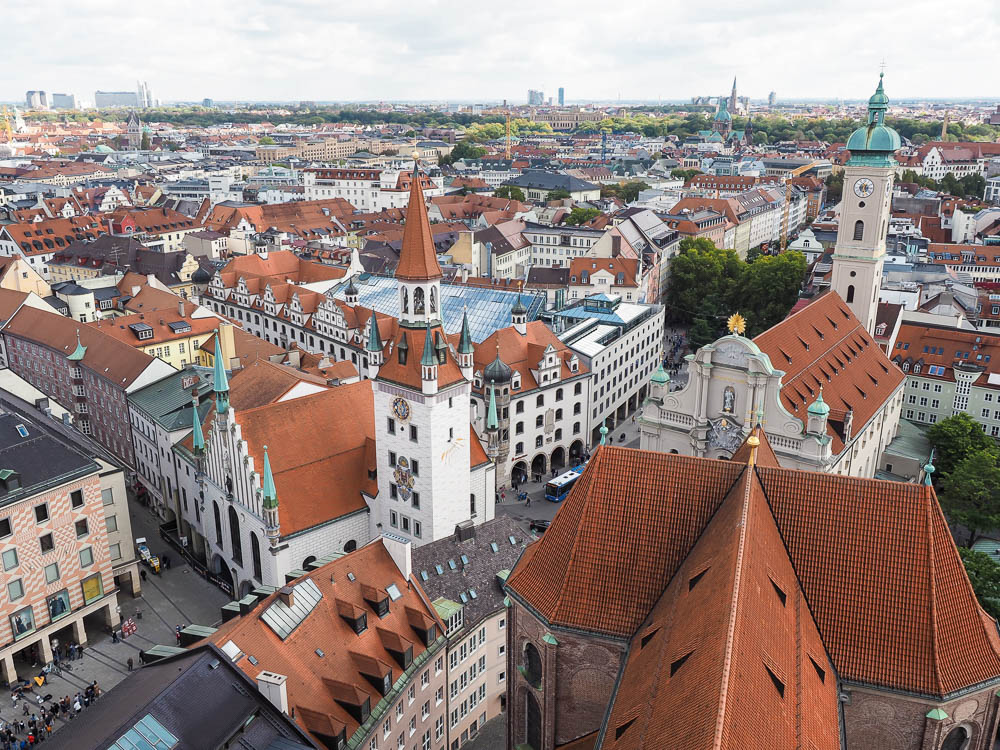
Munich WWII sites
Given how much WWII history happened here in Munich, there are still tons of sites for you to check out–museums, memorials, and many historically-significant locations.
Some of these spots don’t attempt to hide the city’s shameful history. Others offer little-to-no mention of it at all, so don’t be surprised if historical information is hard to come by.
It should go without saying that many of those who call Munich ‘home’ today have a complicated relationship with their city and the past. Wouldn’t you? If this was your hometown and your grandparents we were talking about? Just something to keep in mind as you visit the World War II sites around Munich.
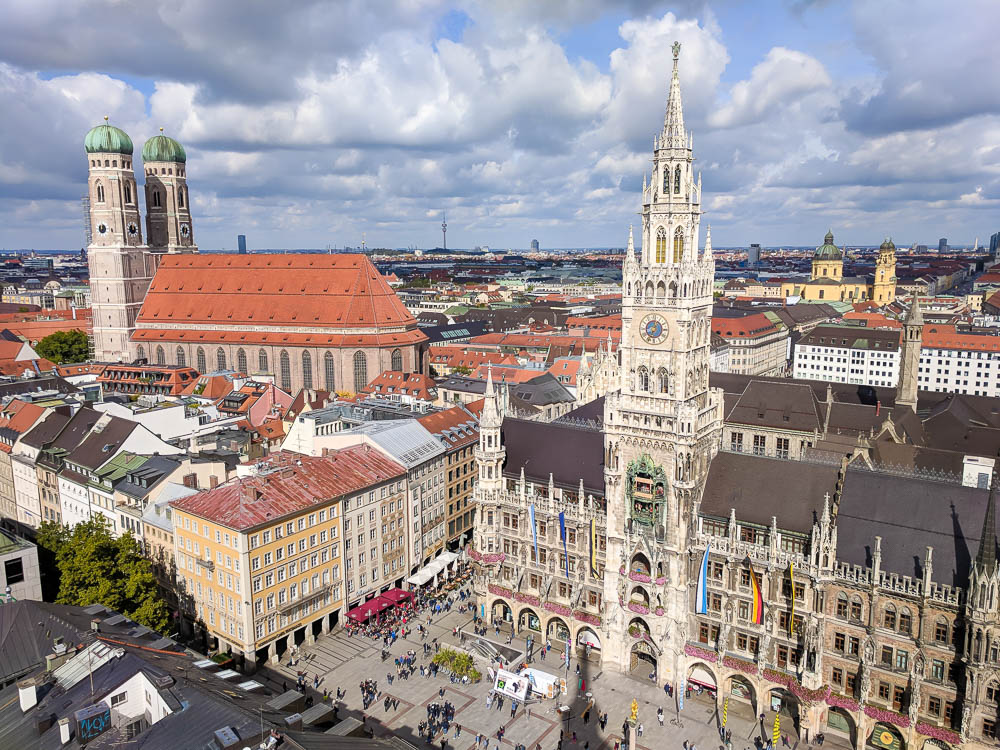
Map of Munich WWII sites
This map contains all the Munich WWII sites I mention in this post. To save this map: Click on the star ⭑ next to the map’s title to save in your Google Maps. To use this map: When you get to Munich, open Google Maps on your phone, click “Saved” at the bottom, then click “Maps.”
Munich WWII sites: Museums
Munich has anything but a shortage of great museums. Here are the ones where you can learn more about the city’s WWII history.
1. NS Documentation Center
Formally known as the Munich Documentation Center for the History of National Socialism, this museum focuses on all things related to the Nazi Party and Munich as its birthplace. As they say, it “documents the origins, the impact, and the consequences of National Socialism up to the present day.”
Exhibits include:
- The origins and rise of the Nazi movement in Munich | 1918-1933
- Nazi rule and society | 1933-1939
- Wartime in Munich | 1939-1945
- Confronting the Nazi past | 1945 until today
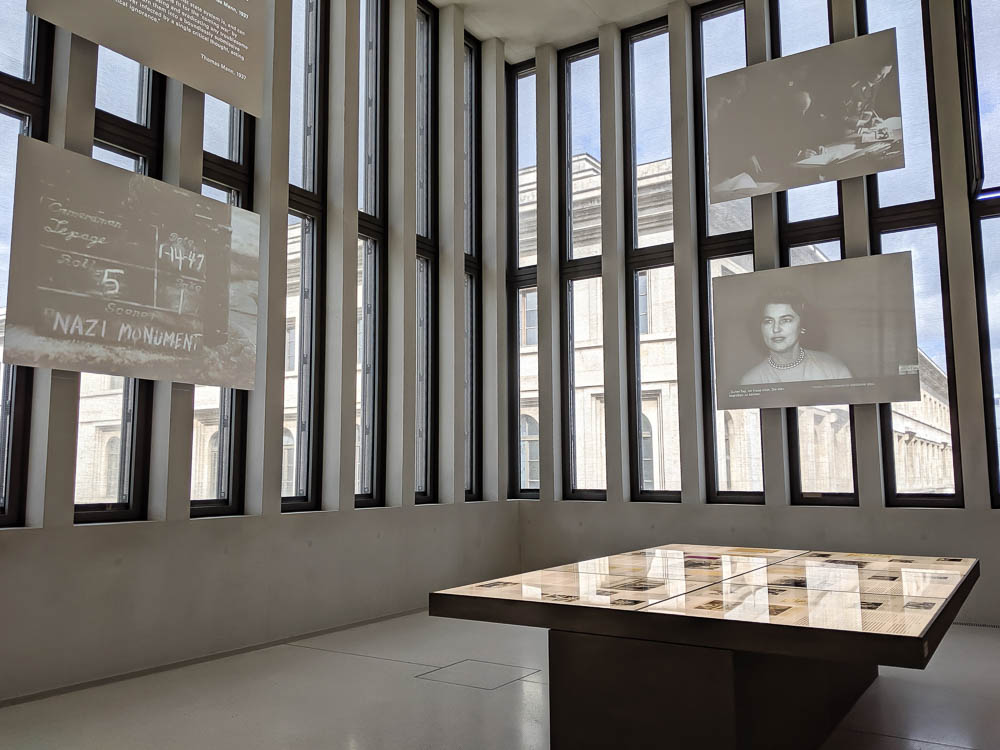
It’s located in a (new) building at the site of the original Nazi Party headquarters and surrounded by the former “Führer Building” and the ruins of the Nazi “Temples of Honor.”
I feel this is one of the most eye-opening museums on the subject of the Nazi Party. It’s the definitive museum on all things related to Nazi Party politics and Munich during WWII. You’d be crazy to not visit this place while you’re in Munich.
- Admission: Free
- Visitor information here: nsdoku.de
- Still need convincing? Read this: 7 Reasons to Visit Munich’s NS-Documentation Center
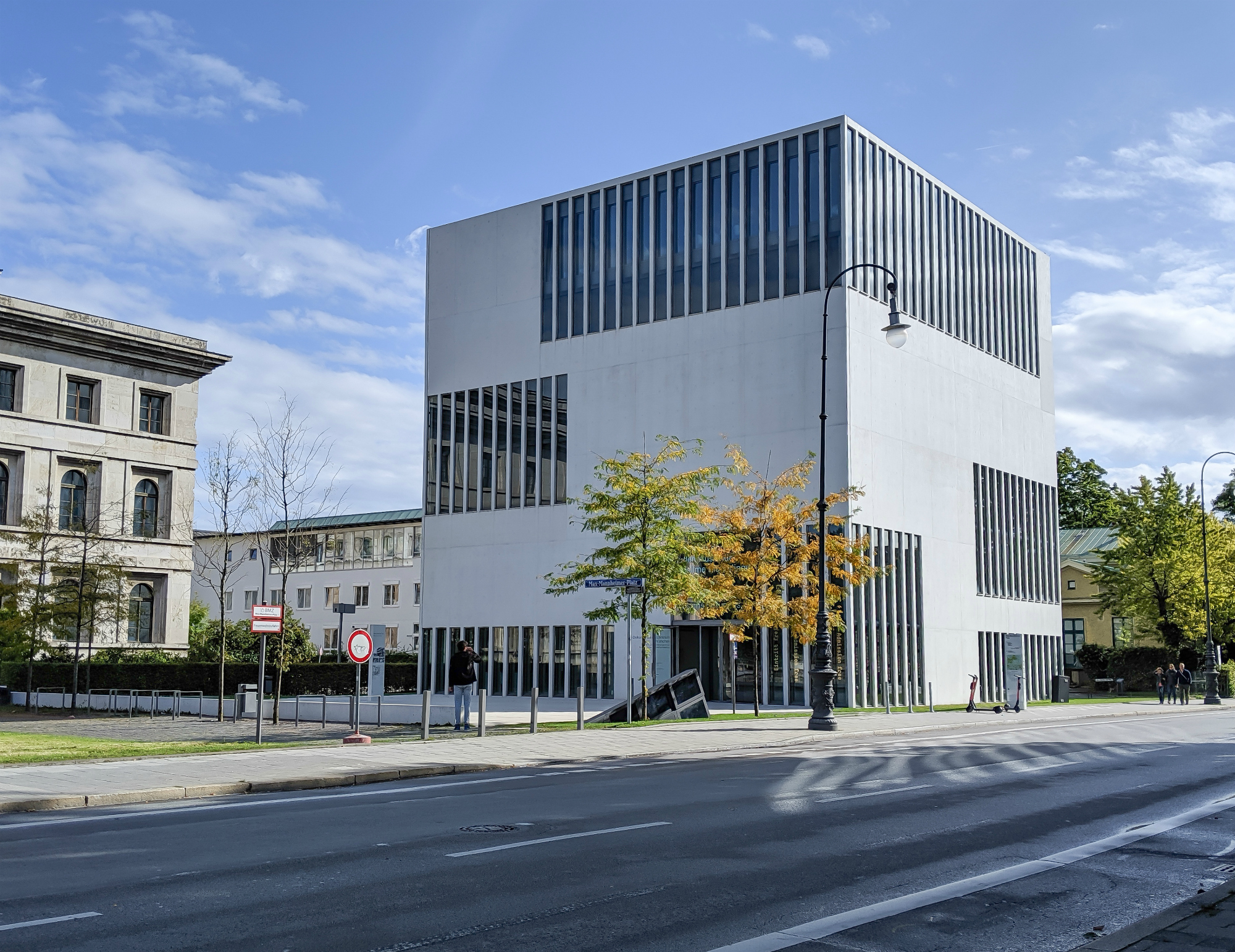
Also check out the full list of must-see WWII Sites in Nuremberg and nearby Regensburg
2. White Rose exhibition at the Justizpalast
Of all the Munich WWII sites to learn about Nazi law and “justice,” the White Rose exhibition inside the Munich Justizpalast is by far the best.
With the White Rose resistance movement as its basis, this exhibition explains the legality behind the Holocaust. In other words, how every corrupt thing the Nazi Party did was completely legal, how they manipulated “law and order,” and more.
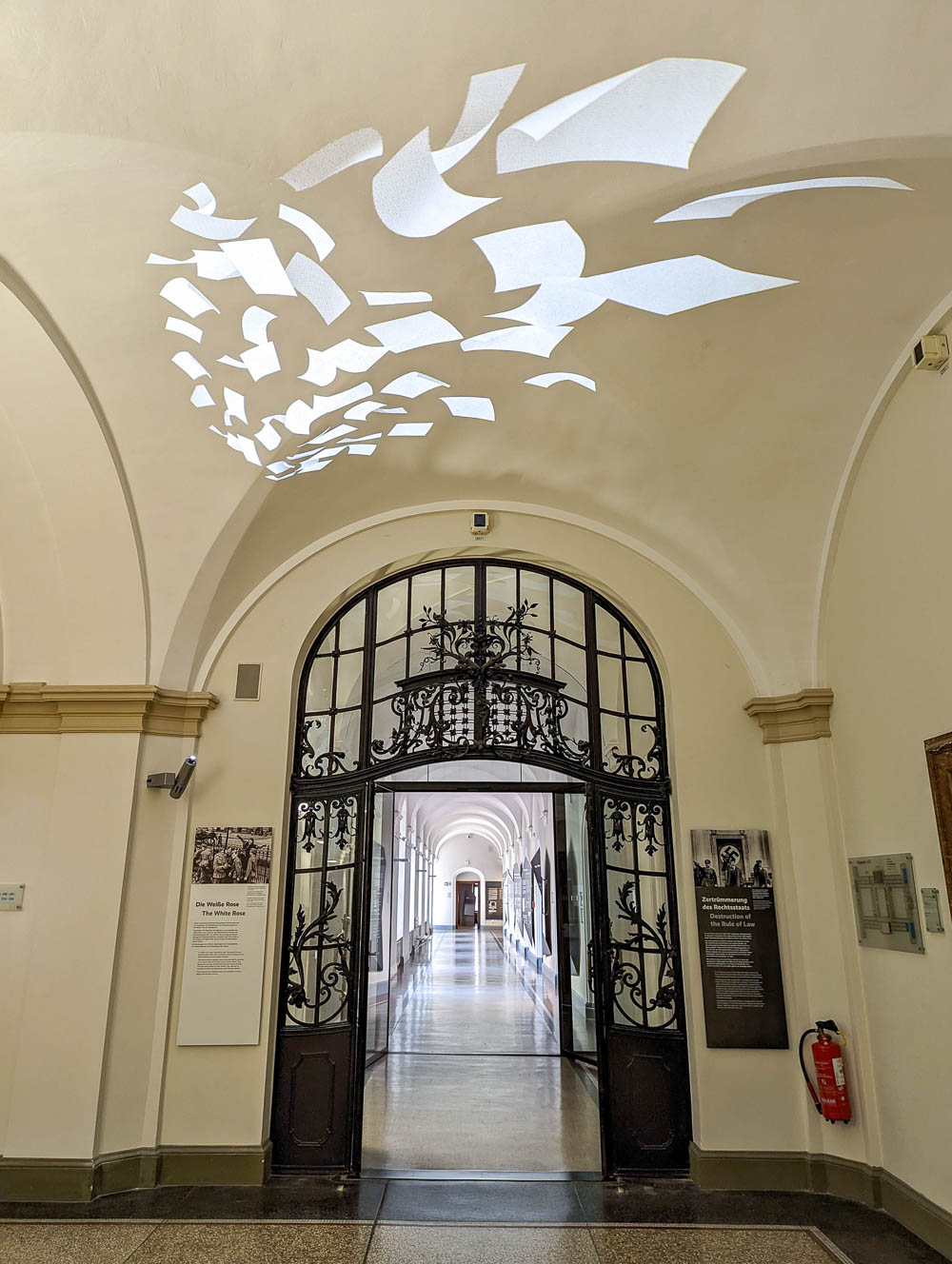
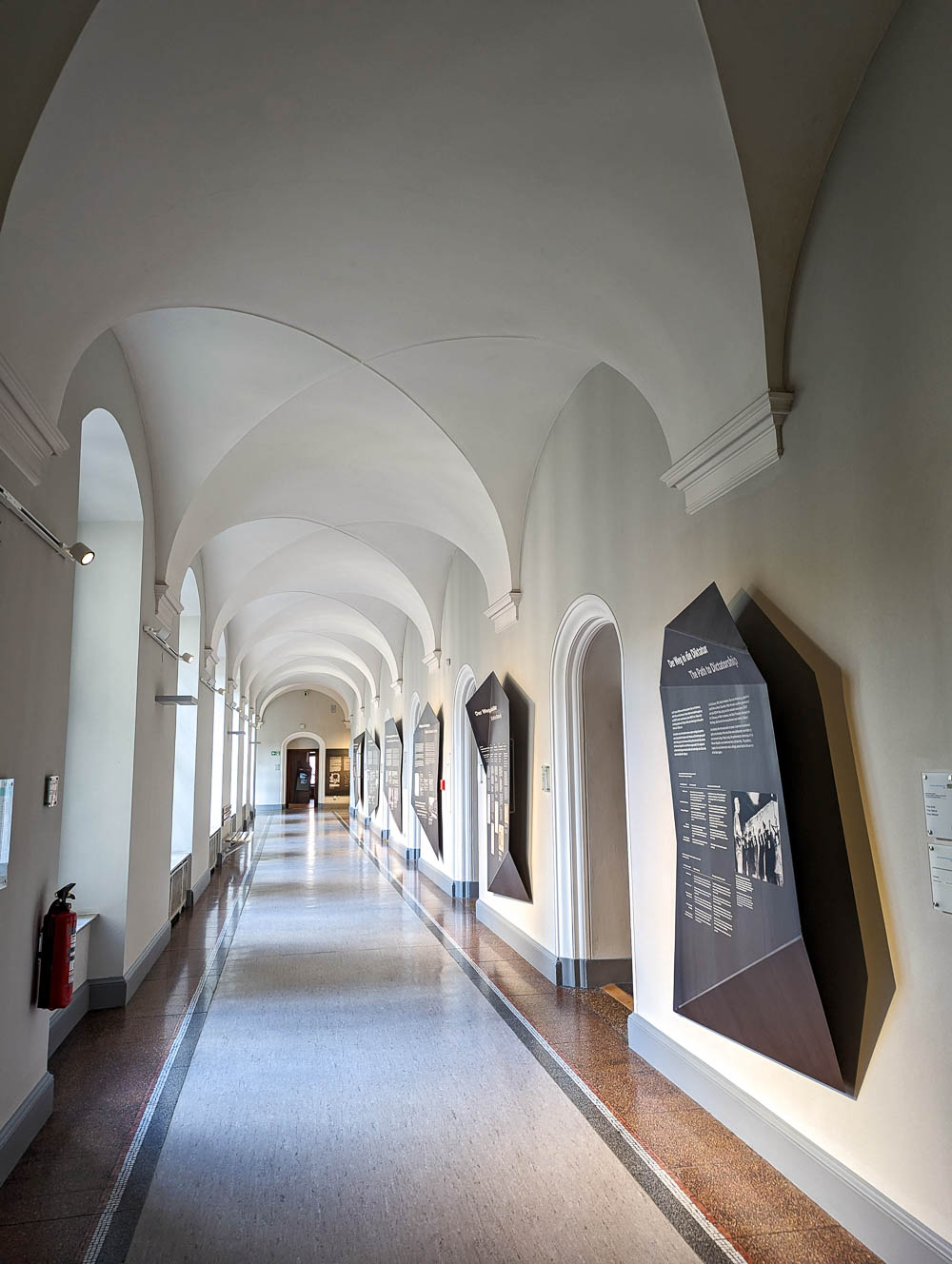
It also explains the history of the White Rose movement—what it was and who was involved, what they accomplished, and how Nazi law determined their fates. Part of the exhibition incorporates the actual courtroom where the White Rose trials were held.
I personally find this topic super interesting so I absolutely love this exhibit. It presents the information so clearly and in such an engaging way. (Plus, the Justizpalast is a beautiful historical building worth visiting alone.)
- Admission: Free
- Visitor information here: justiz.bayern.de
- Want more on this? Read my full guide to White Rose sites in Munich here.
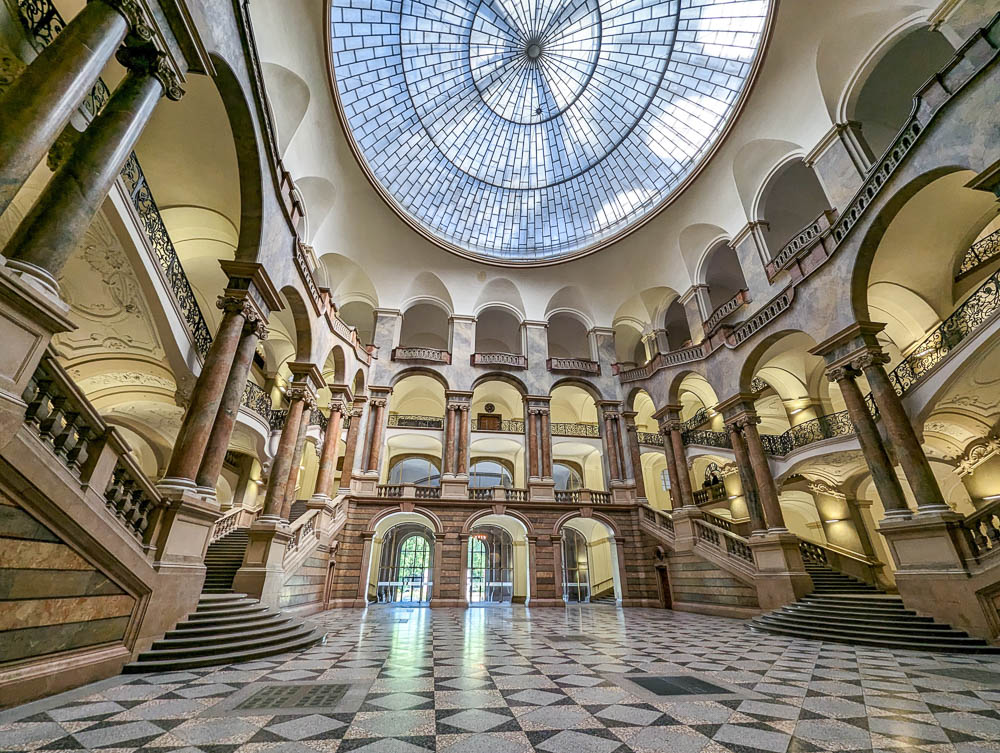
3. White Rose exhibition at LMU
The White Rose movement formed among students at Munich’s Ludwig-Maximillian University. Today, you can visit the university and its permanent museum dedicated to this famous resistance group.
Located at the very spot where the identities of the group’s leaders were discovered, this museum “offers a comprehensive overview of the history of the White Rose and places their resistance in the context of the National Socialist terror regime and the criminal war.”
You’ll get full biographies on group members and other key figures, the full contents of their six game-changing leaflets, and so much more. Plus, the staff can answer any questions you have. (I always have questions.)
- Admission: Free
- Visitor information here: weisse-rose-stiftung.de
- Want more on this? Check out my full guide to White Rose sites in Munich here.
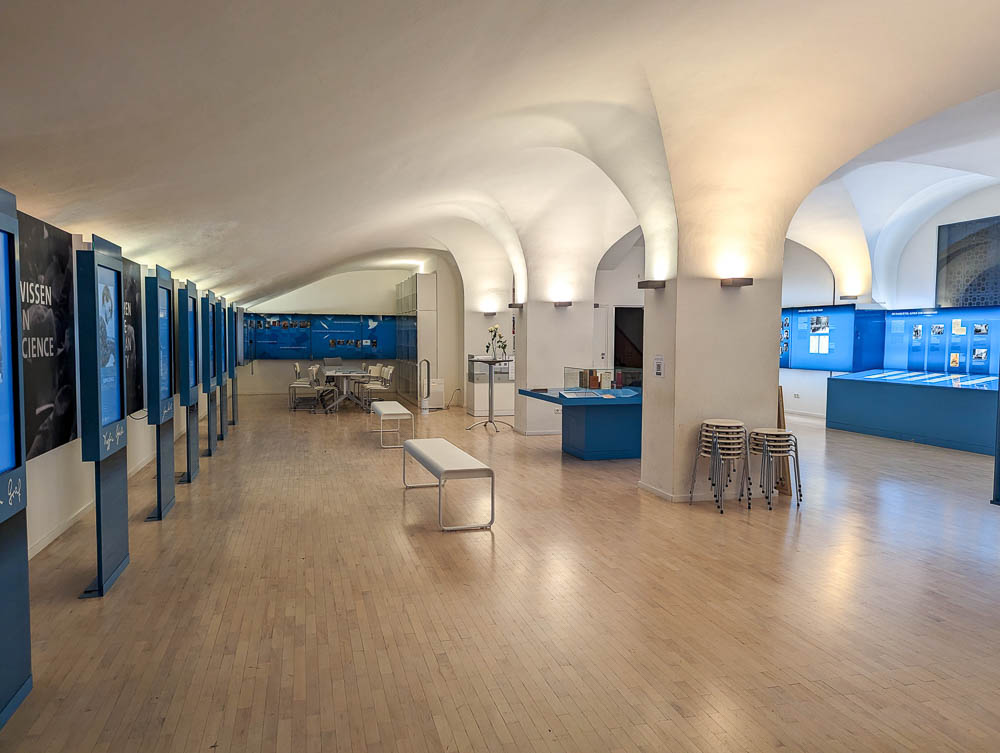
4. Munich City Museum (Münchner Stadtmuseum)
The Munich City Museum is Germany’s largest municipal museum, both in terms of physical size and the size of its collection. It focuses on topics related to Munich’s history, but also contains exhibits on tons of other (unrelated) topics as well. For our purposes, there’s an entire section dedicated to National Socialism in Munich.
This wing is located outside, in the building across from the museum’s main entrance. (Did I walk through this entire museum only to learn this the hard way? Of course I did. It wasn’t entirely my fault—there’s no signage explaining this and, surprise surprise, they don’t exactly go out of their way to direct you here, but I digress.)
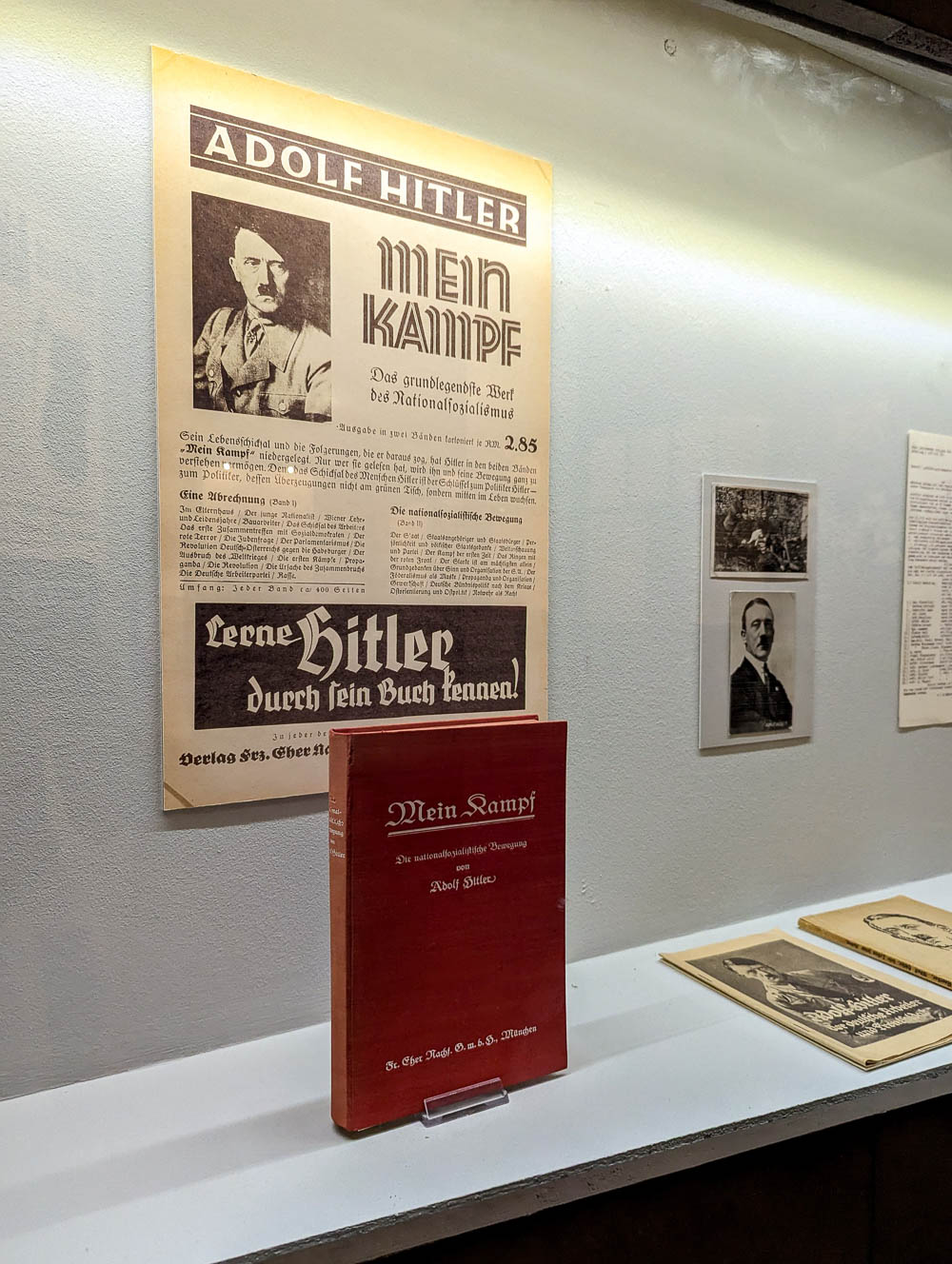
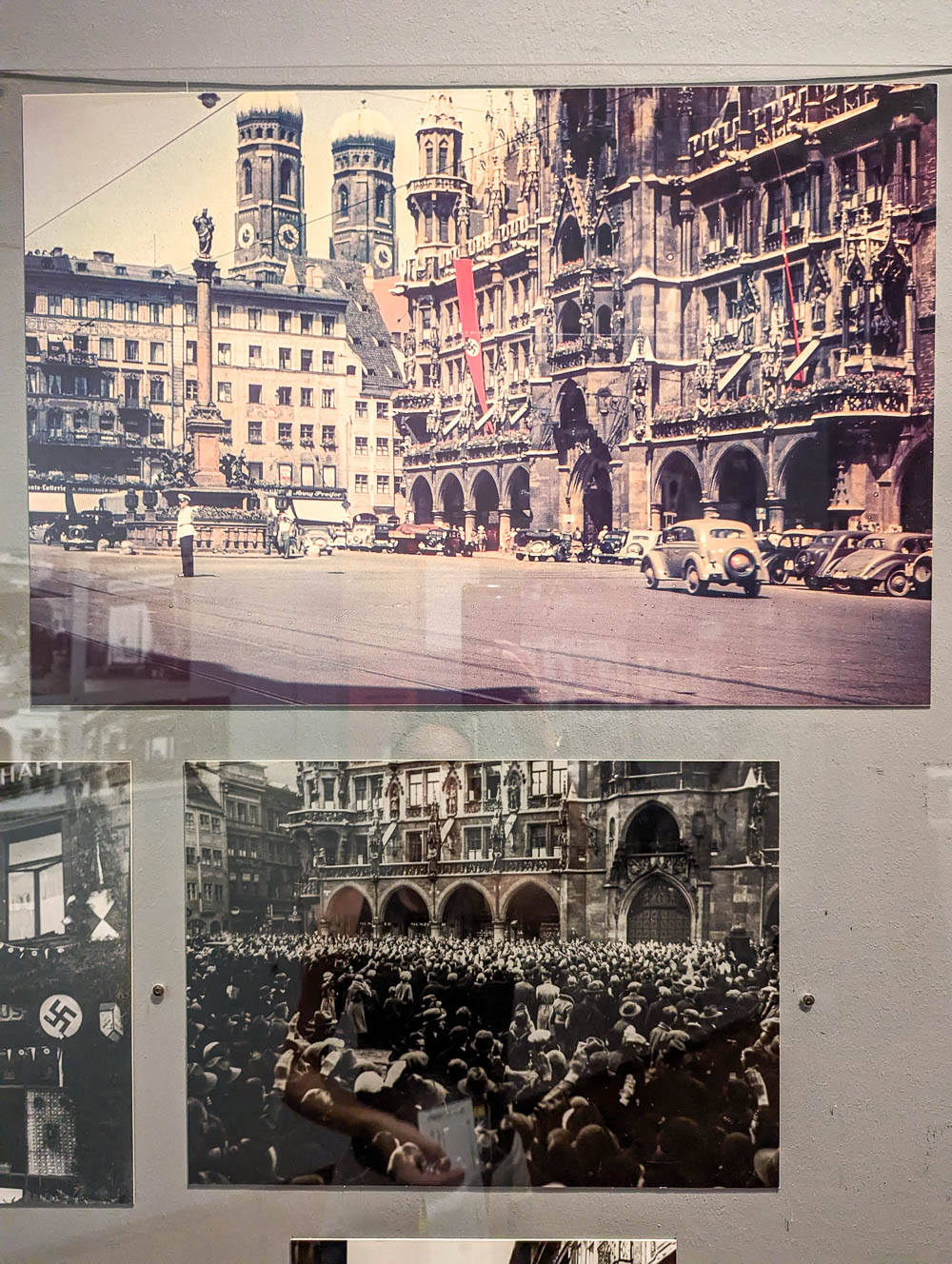
This section of the museum summarizes Munich during the Third Reich—but you already learned all there is to know at the NS-Documentation Center. The real reason for visiting this museum is because of the collection of incredible artifacts related to this topic. (I love reading about these topics, don’t get me wrong, but my favorite museums are the ones where you get to see *stuff.*)
The Munich City Museum has an (dare I say it) awesome collection of Nazi-era artifacts that’s definitely worth stopping by for. It’s just a couple blocks from the Marienplatz and super easy to get to. The whole museum could take you hours to explore, but the WWII section may only take about 30-45 minutes.
However, note that the displays here are only in German. This is one of those times when they don’t make it easy for non-Germans to understand the content. Intentional? Who’s to say. Have your translator app fired up and you’ll be fine.
- Admission: See below
- Visitor information here: muenchner-stadtmuseum.de
Important note!
I visited the Munich City Museum in late September 2023 but shortly afterward it closed for renovations and “reconceptualization.” Actually, this is a full reconstruction that will take an estimated seven years to complete. They plan to reopen mid-2031. But I already wrote this section so I’m leaving it here. I’ll update this post in 7 years (lol) when the museum reopens (hopefully with English-language displays).

5. Jewish Museum Munich
Also near the Marienplatz is the Munich Jewish Museum which focuses on the “diversity of Jewish history and culture” as well as “the subjects of migration and inclusion.” Naturally, you’re going to learn about Jewish life in Munich during World War II here.
They also have several temporary exhibitions throughout the year on various topics. During my visit in September 2023, it was: “Munich Displaced. The Surviving Remnant” which detailed the varying experiences of Jews in Munich immediately following the war. Super interesting.
- Admission: €3
- Visitor information here: juedisches-museum-muenchen.de
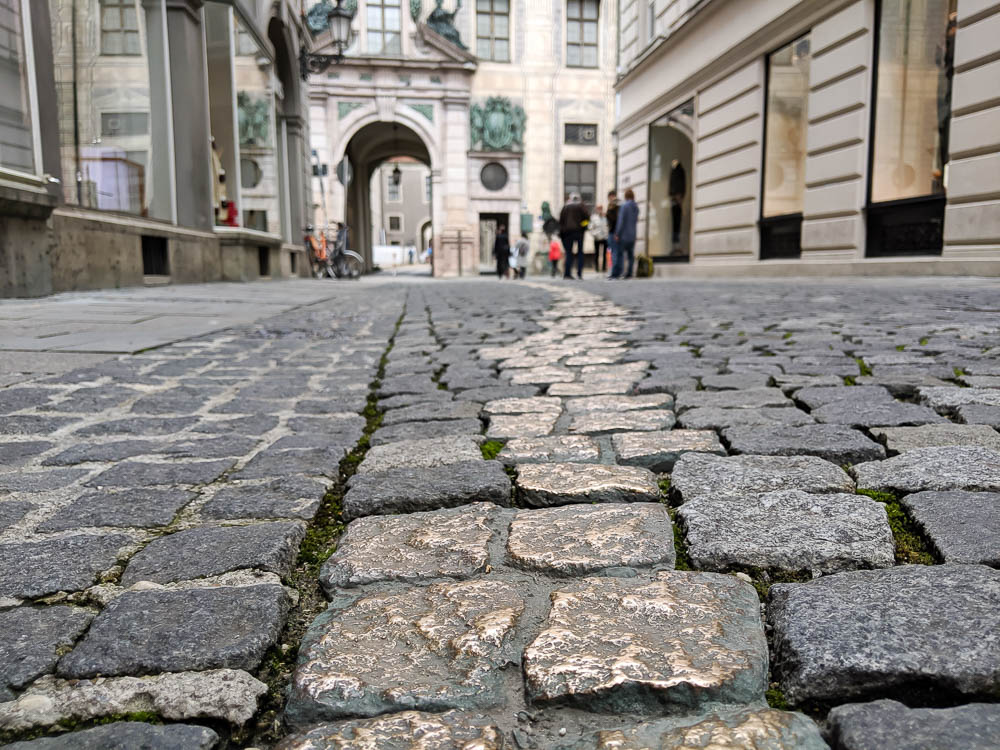
Munich WWII sites: Memorials & monuments
Here are some of the most interesting WWII memorials in Munich. Some of these are pretty discreet and would be super easy to overlook, so keep your eyes peeled.
6. Viscardigasse / “Shirker’s Alley”
One of Nazi Germany’s most venerated monuments was located at the Feldhernnhalle in central Munich. This served as their monument to the “martyrs”—the 16 Nazis killed during the Beer Hall Putsch. The adjoining square was used for important rallies, ceremonies, and events.
Because of its status, anyone who passed by it was ordered to salute it (with the Nazi salute). However, not everyone supported the Nazi Party and thus chose to opt out, more or less. As a show of resistance, those people would slip down the alley behind the Feldhernnhalle instead, thus avoiding having to give the Nazi salute.
Today, there’s a subtle monument to this act of passive resistance on Viscardigasse (nicknamed “Shirker’s Alley”). Look for the path of bronze cobblestones hidden among the rest.
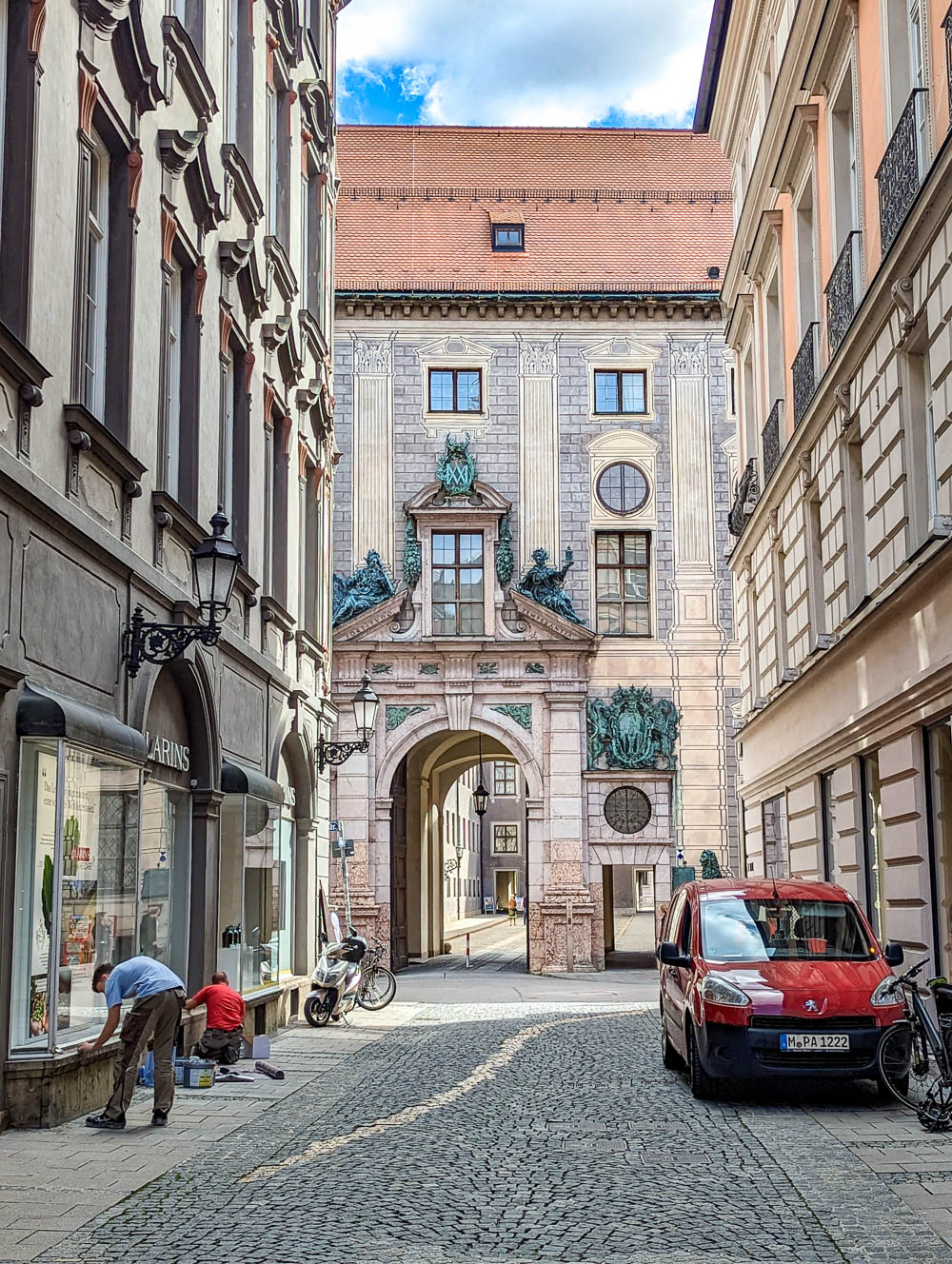
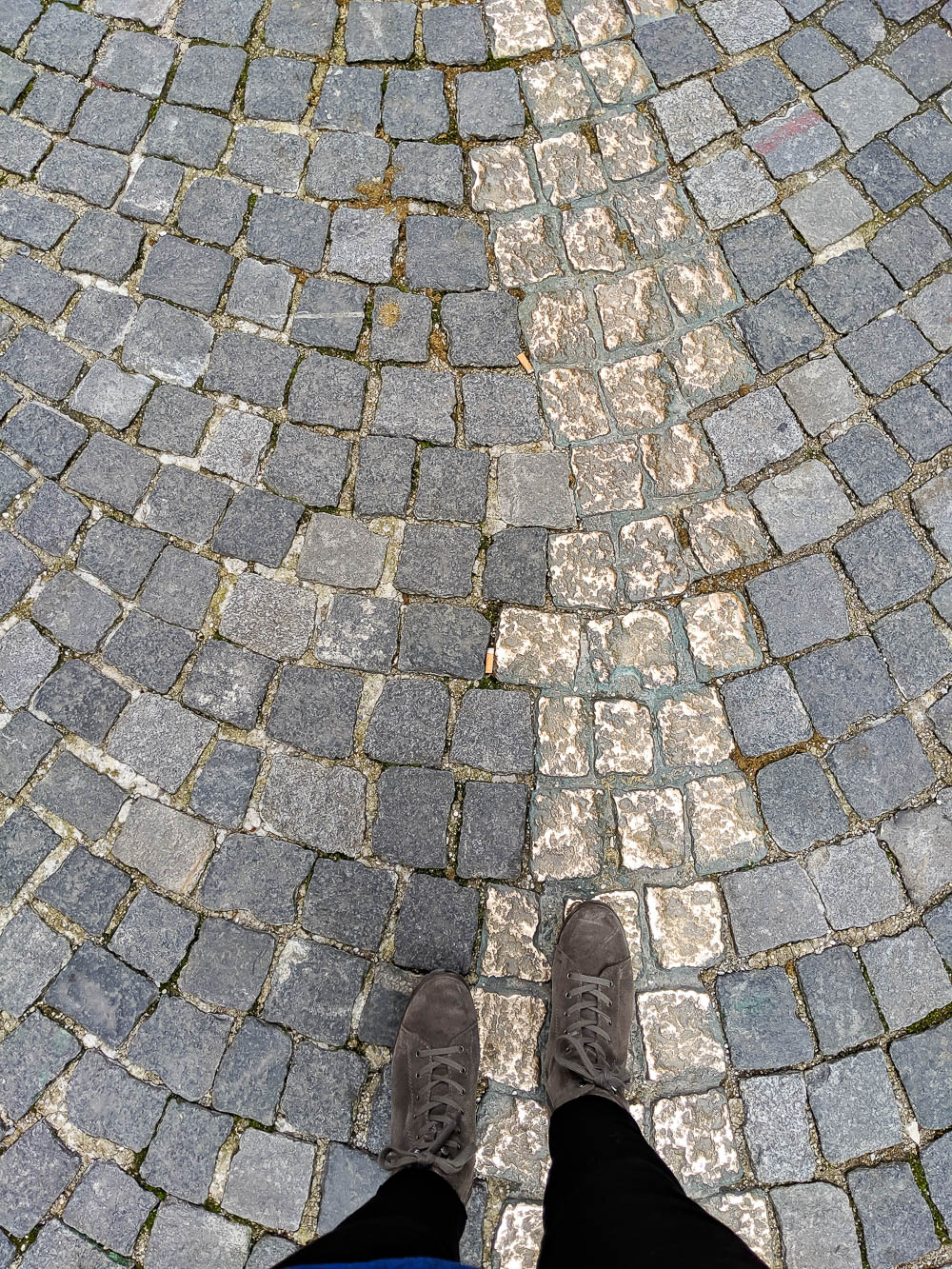
7. White Rose Scattered Leaflets memorial
Because the history of the White Rose movement is so important to Munich’s history, you can find several memorials dedicated to it among the many Munich WWII sites. The most well-known of these is the scattered leaflets memorial at LMU.
Just outside the entrance to LMU (and the White Rose atrium) you’ll find a memorial inlaid in the pavement resembling a stack of scattered leaflets. Some of them show copies of the leaflets; others give details about the group’s members.
White Rose member Sophie Scholl was seen pushing a stack a leaflets from the second floor into the atrium, which led the school’s janitor to turn her in. She was consequently arrested and then executed. This memorial aims to mimic her last scattering of pamphlets.
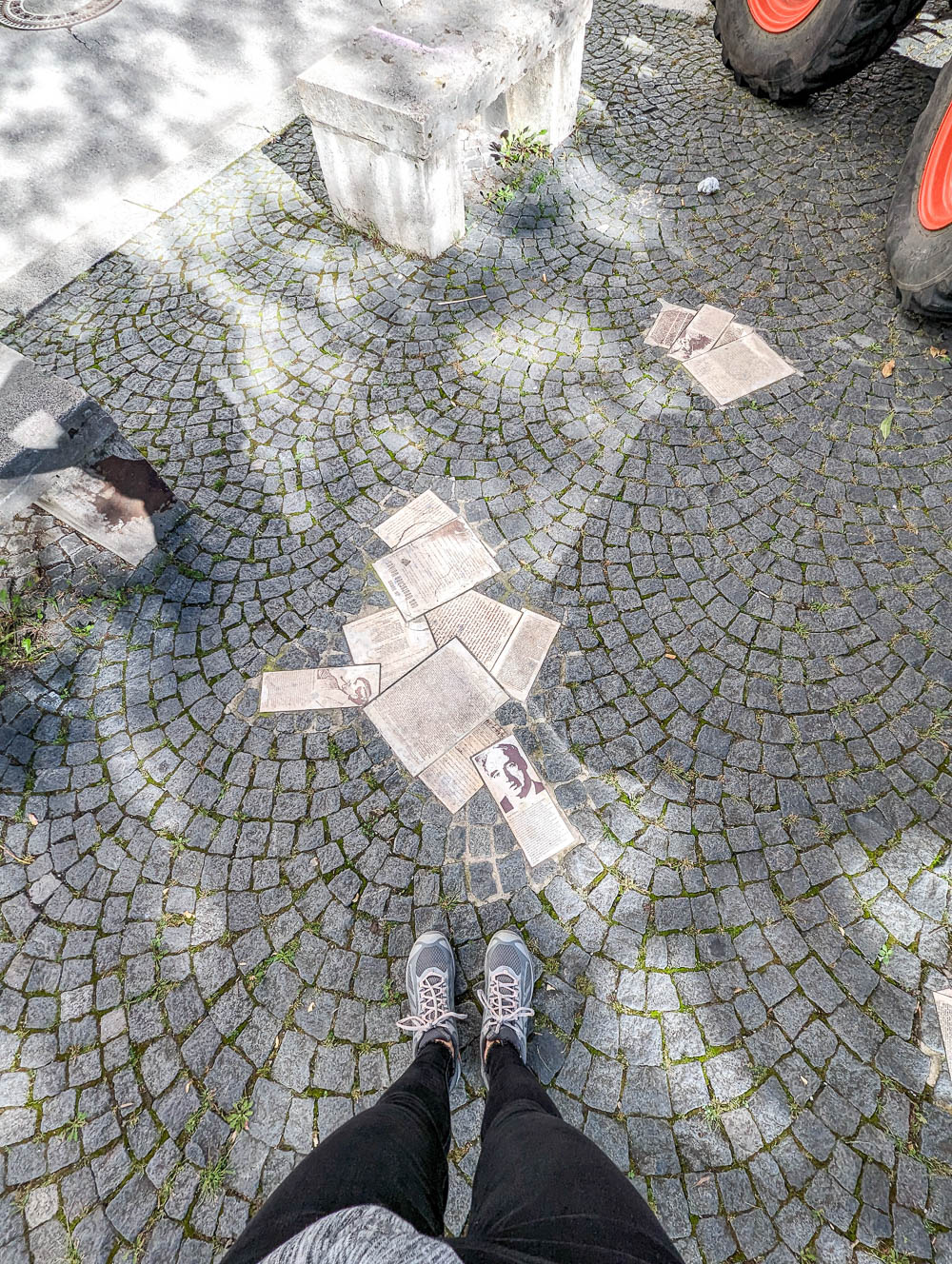
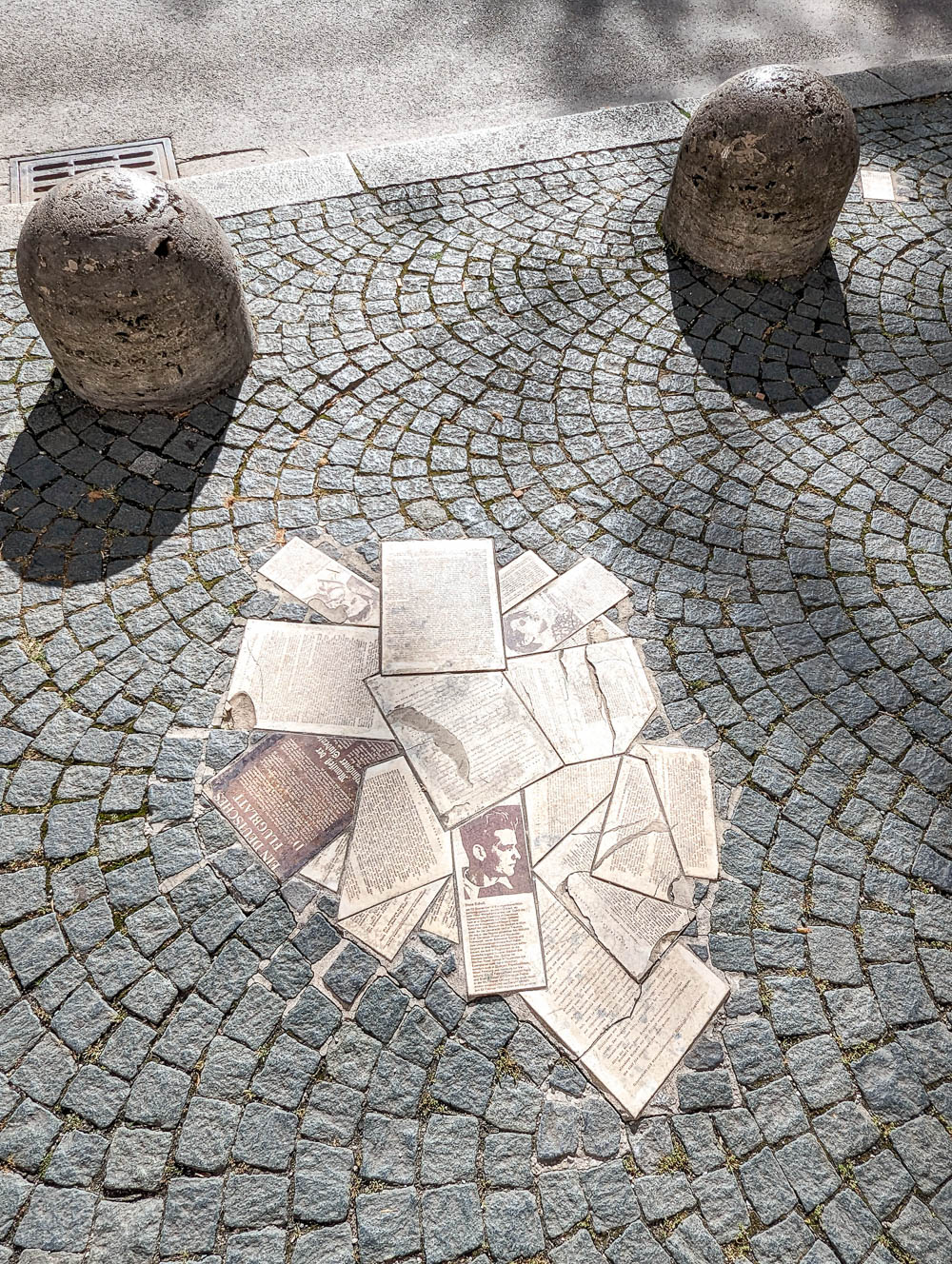
8. Other White Rose memorials
You can also find several White Rose memorials inside the university’s atrium as well:
- The White Rose organ
- A bronze bust of Sophie Scholl outside the museum’s entrance
- A bronze relief sculpture of the seven group members who were executed, along with their inscribed names
In Munich’s Hofgarten, you’ll find the White Rose Monument—a cube-shaped monument dedicated to the White Rose and all those who actively resisted the Nazi regime.
For the full list of White Rose memorials in Munich, see my full guide in that link.
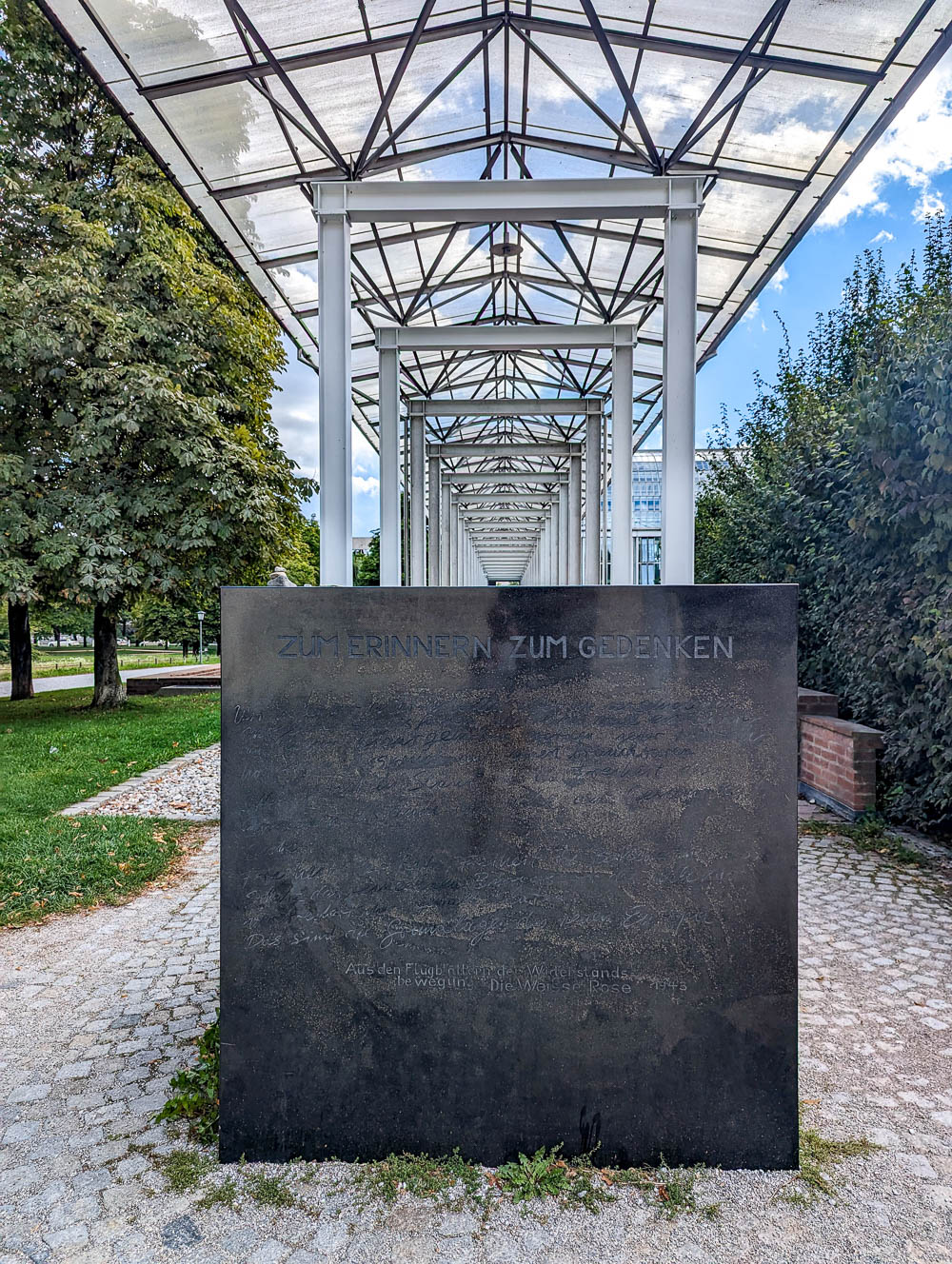
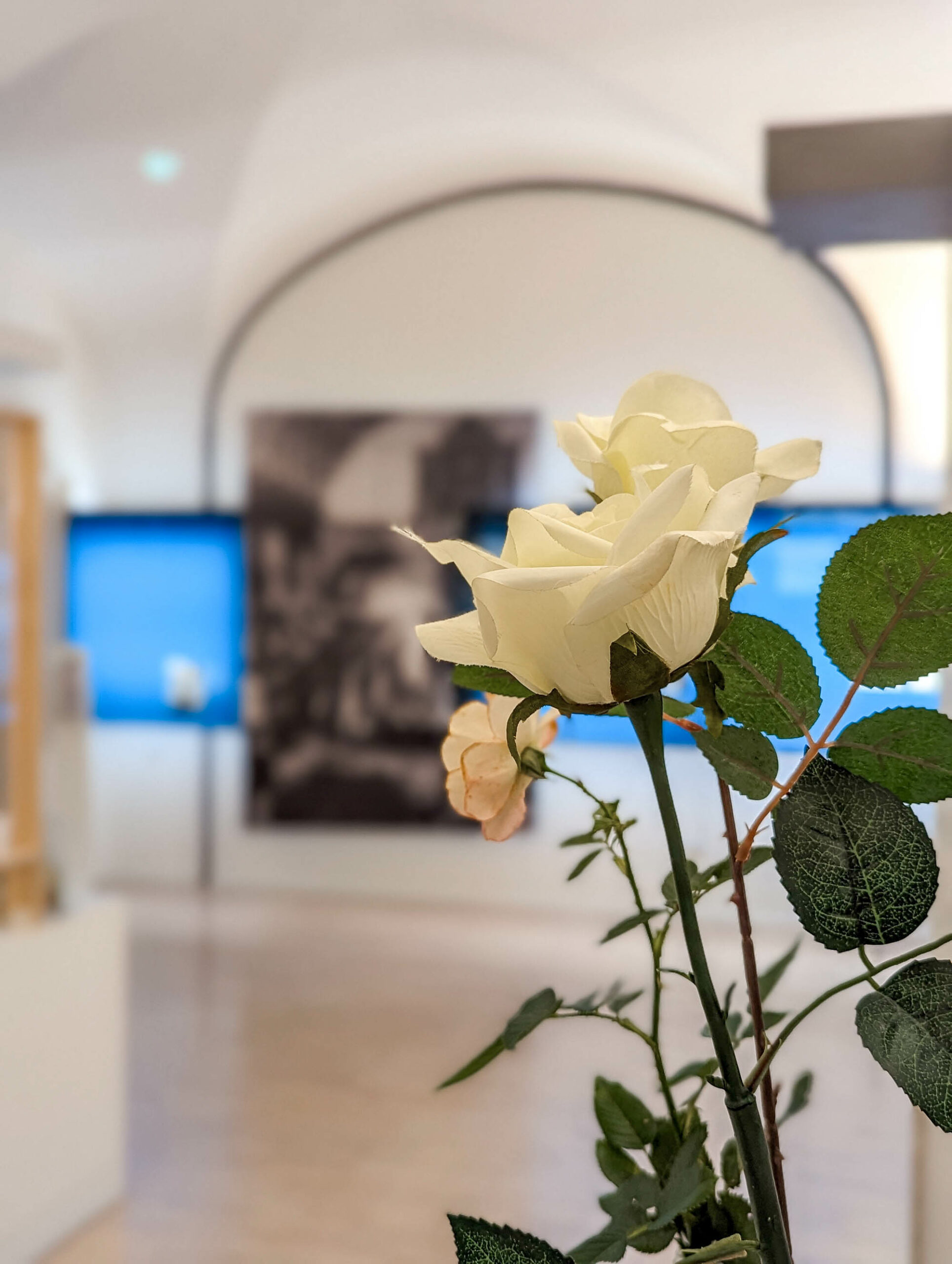
9. Holocaust memorial plaques
In just about every city in Europe you’ll be able to find “stumbling stones” (stolpersteine in German). That is, every city except Munich and Paris who both deemed their placement in the ground inappropriate.
In lieu of those but along the same vein, in 2018 Munich began installing their own brand of Holocaust memorial plaques outside the former homes of Holocaust victims. They can honor one victim, or several.
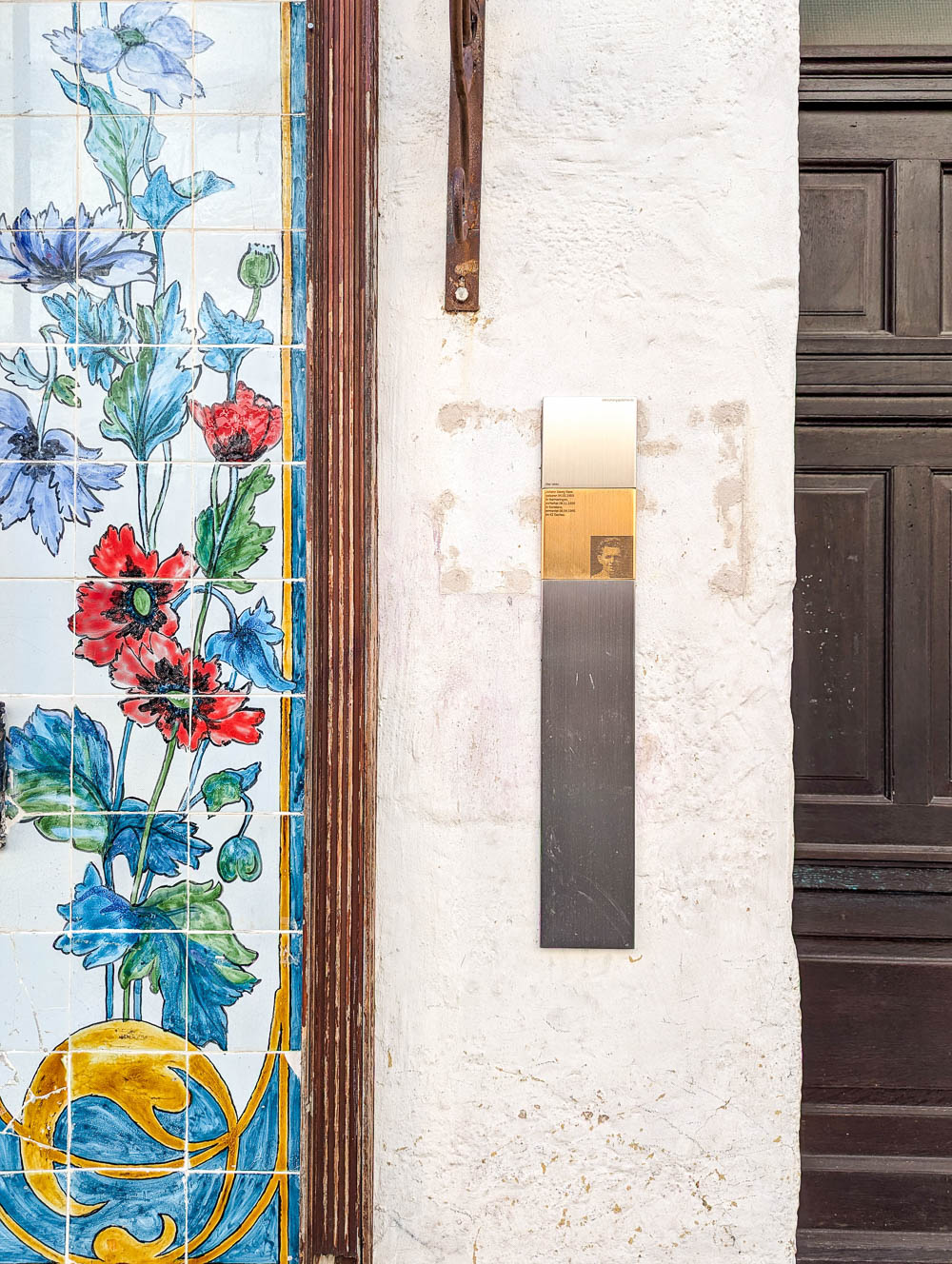
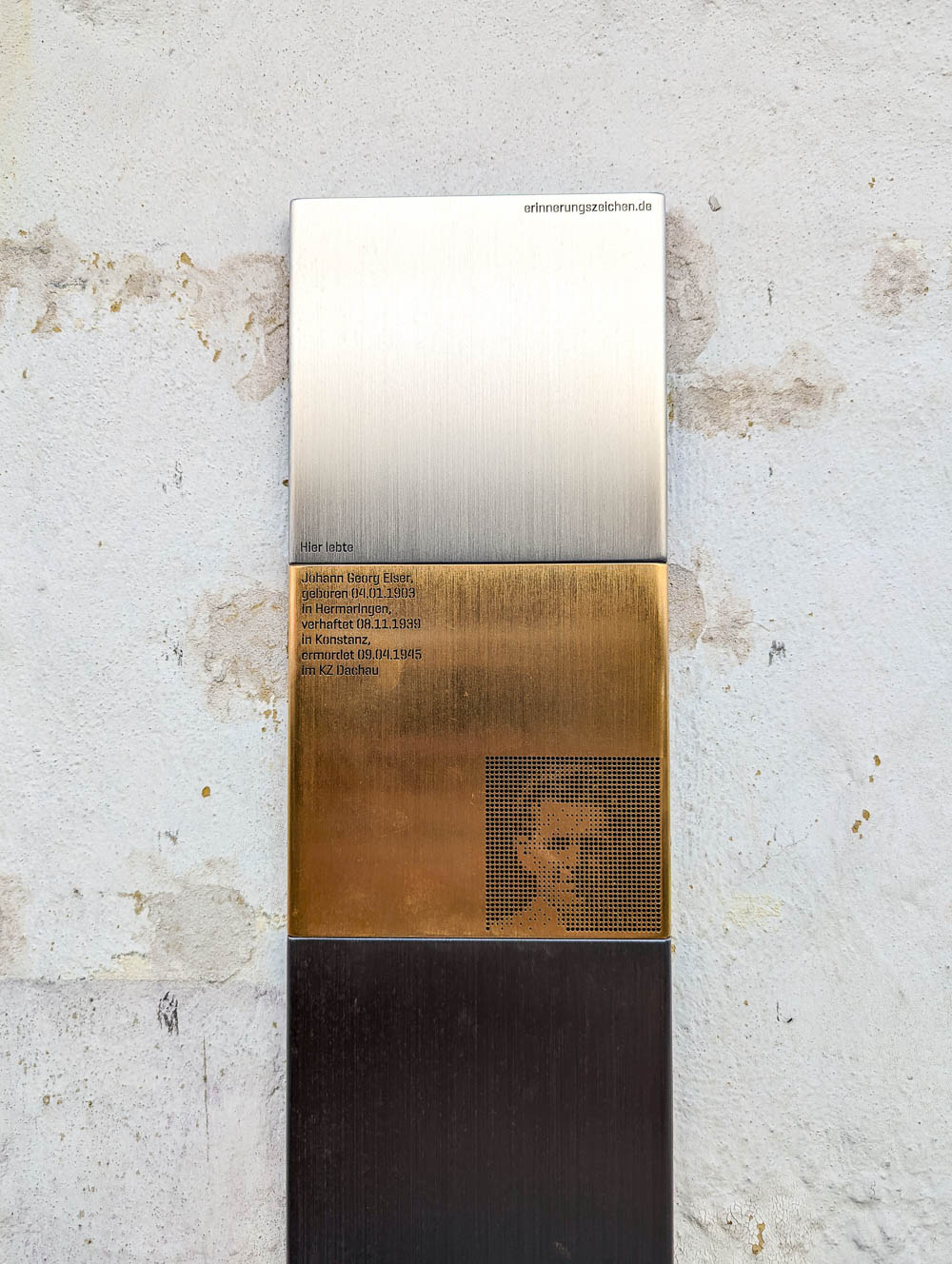
Sometimes they’re attached to the buildings themselves (usually near an entrance); other times they’re on detached poles in front of the house. Sometimes they’re horizontal instead of vertical. Regardless of these details, they always provide the same general information:
- The victim’s name
- Their date of birth
- What happened to them, i.e. what camp they were deported to, the date they were killed, etc.
- And a stylized image of their face if available
You can find these all over Munich, but if you want some examples of exactly where you can see them, stop by:
- Türkenstraße 94 – Georg Elser, on the wall next to the door
- Bavariaring 15 – Albertine Neuland, on one of the concrete pillars along the fence (near the main entrance to Oktoberfest)
- Franz-Joseph-Straße 15 – Emma & Jakob Springer, on a detached pole next to the door (They lived next door to Hans & Sophie Scholl.)
- Frauenstraße 24 – Karoline, Isaak, Julius, and Klara Bacharach, attached to the building by the door

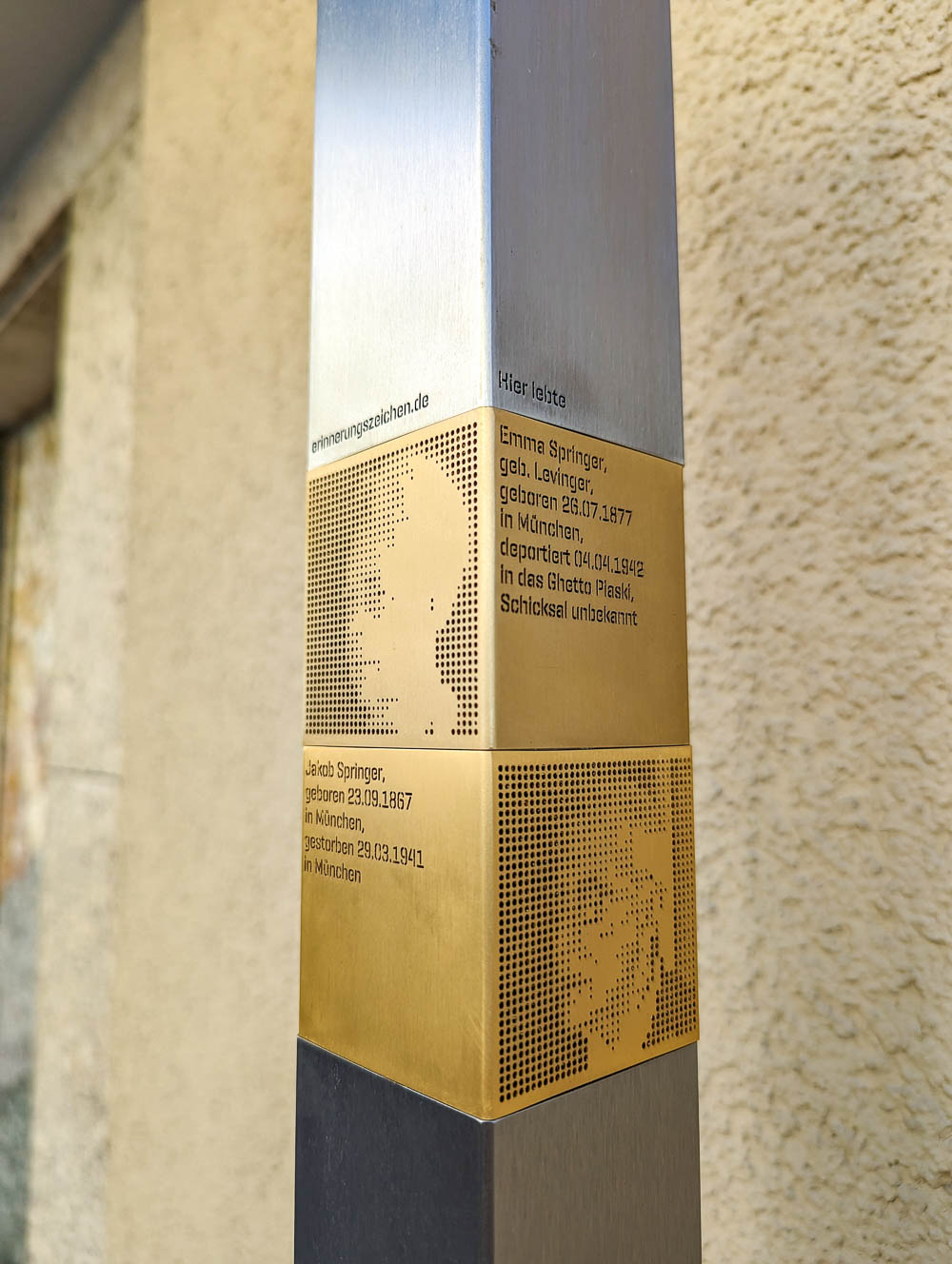
10. Klingenbeck Stumbling stone
That being said, though the city of Munich has disavowed stumbling stones, they are still permitted on private property. So, in September 2023, the Church of St. Ludwig (across the street from Ludwig-Maximilian University) installed one just outside their front doors.
This particular stolpersteine is dedicated to Walter Klingenbeck, a 19-year old German resistance fighter and member of this church. You can read more about him here. Be sure to stop by this small memorial since these stones are such a rarity here in Munich!
For more on these stones in general and the controversy surrounding them in Munich, see my full post on Stolpersteine here.
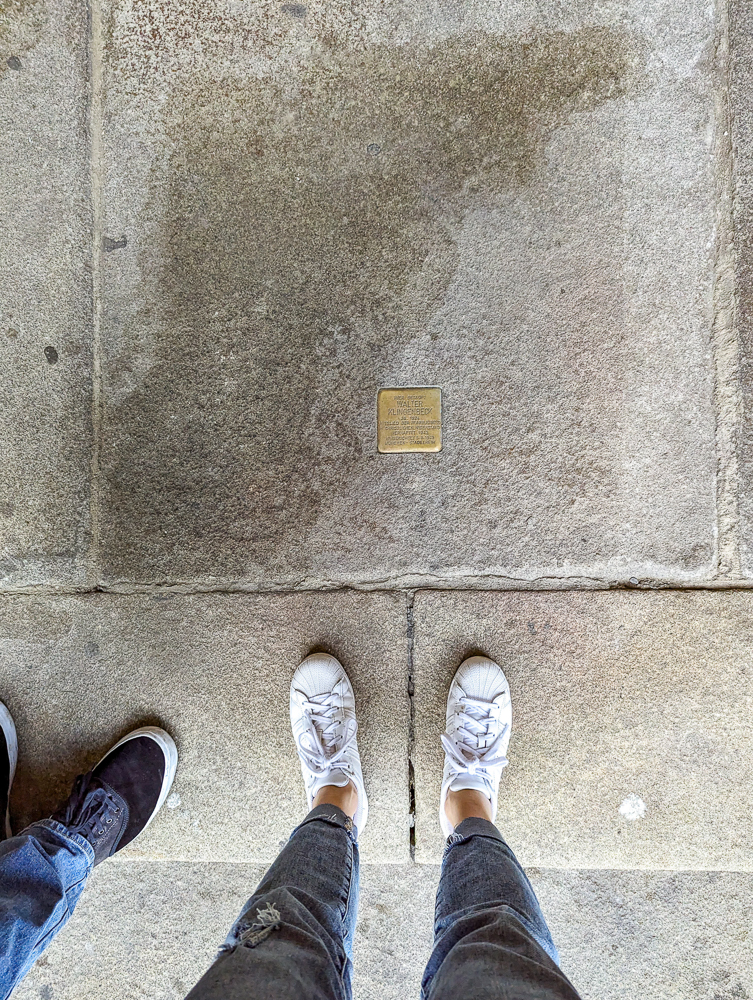
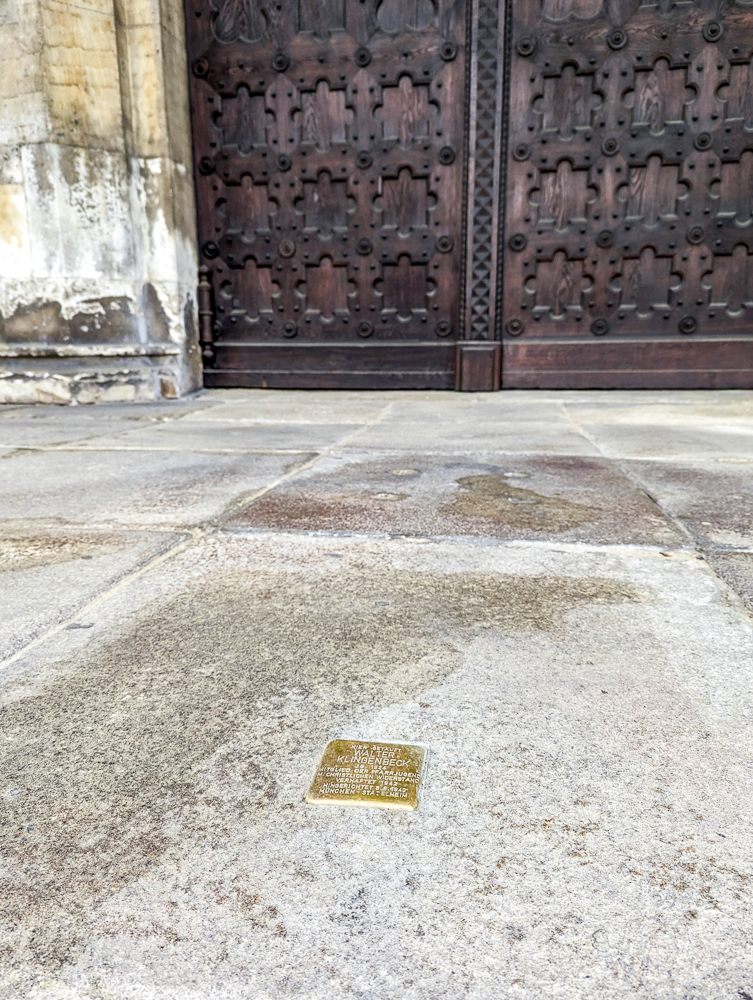
11. Main Synagogue Memorial (Hauptsynagoge)
This large cube-shaped memorial stands at the former location of Munich’s main synagogue, destroyed in June 1938 on Hitler’s orders. It was the first synagogue in Germany to be destroyed by the Nazis.
This memorial was installed in 1969 and has several inscriptions (in German and Hebrew). You’ll see on the front (flat) side:
- “Here stood the Main Synagogue of the Jewish community, built in 1883-87. In the time of the persecution of Jews, it was destroyed in June 1938. On 10 November 1938, in Germany, synagogues were burnt down.”
- “Remember this, how the enemy has mocked you, Lord” Psalm 74, Verse 18
On the back, right: “They burned all the meeting places of God in the land” Psalm 74, Verse 8. On the back, left: “They burned your sanctuary to the ground; they defiled the dwelling place of your Name” Psalm 74, Verse 7
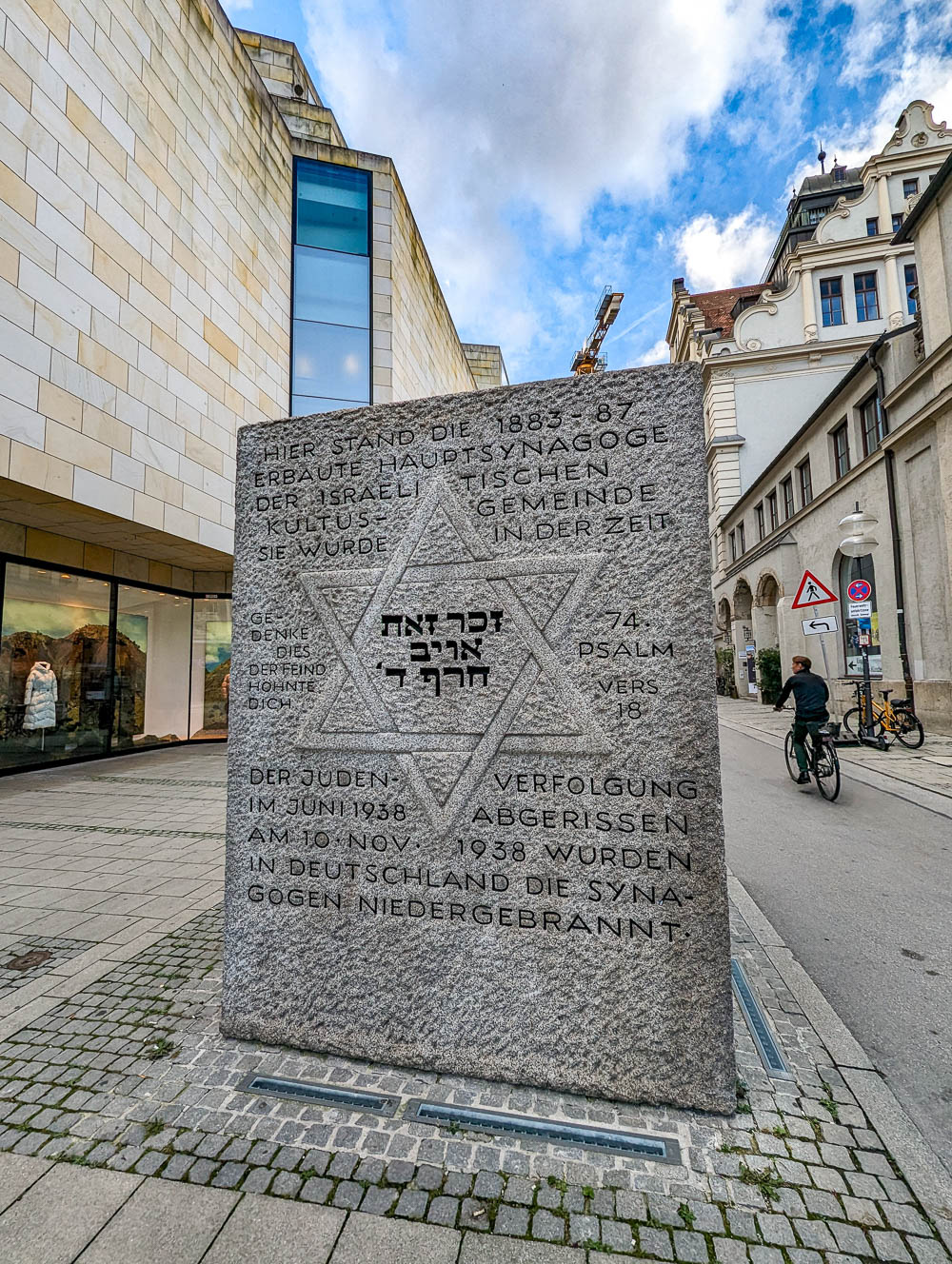
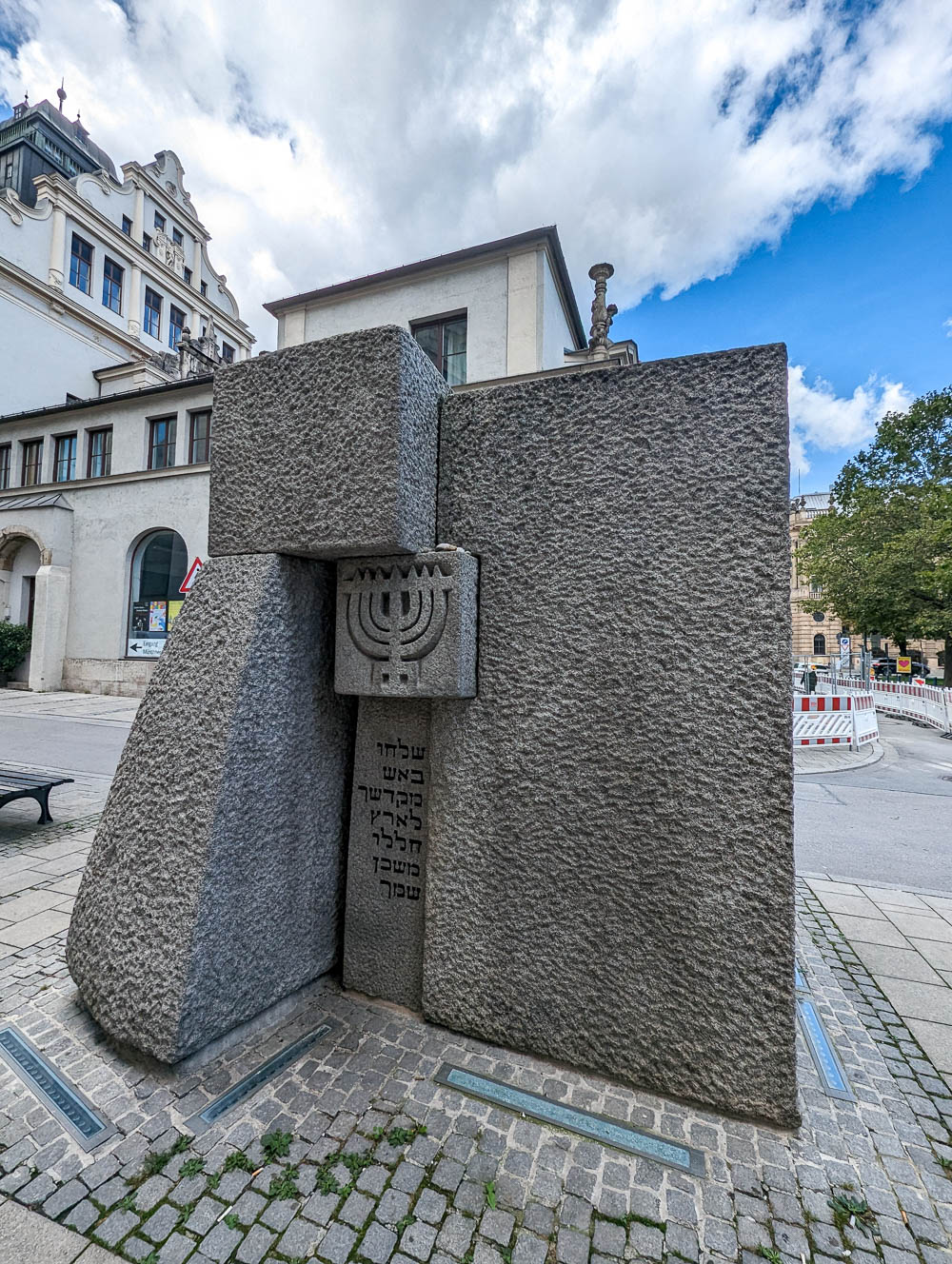
12. Memorial to the Victims of National Socialism
This memorial near the center of town is situated in the “Square for the Victims of National Socialism,” so named for its location near the former site of the Gestapo headquarters. It consists of a tall black granite memorial containing an eternal flame.
In front of it stands a long bronze wall (that also looks black) with the inscription (in German): In memory of the victims of National Socialist tyranny.” More information here.
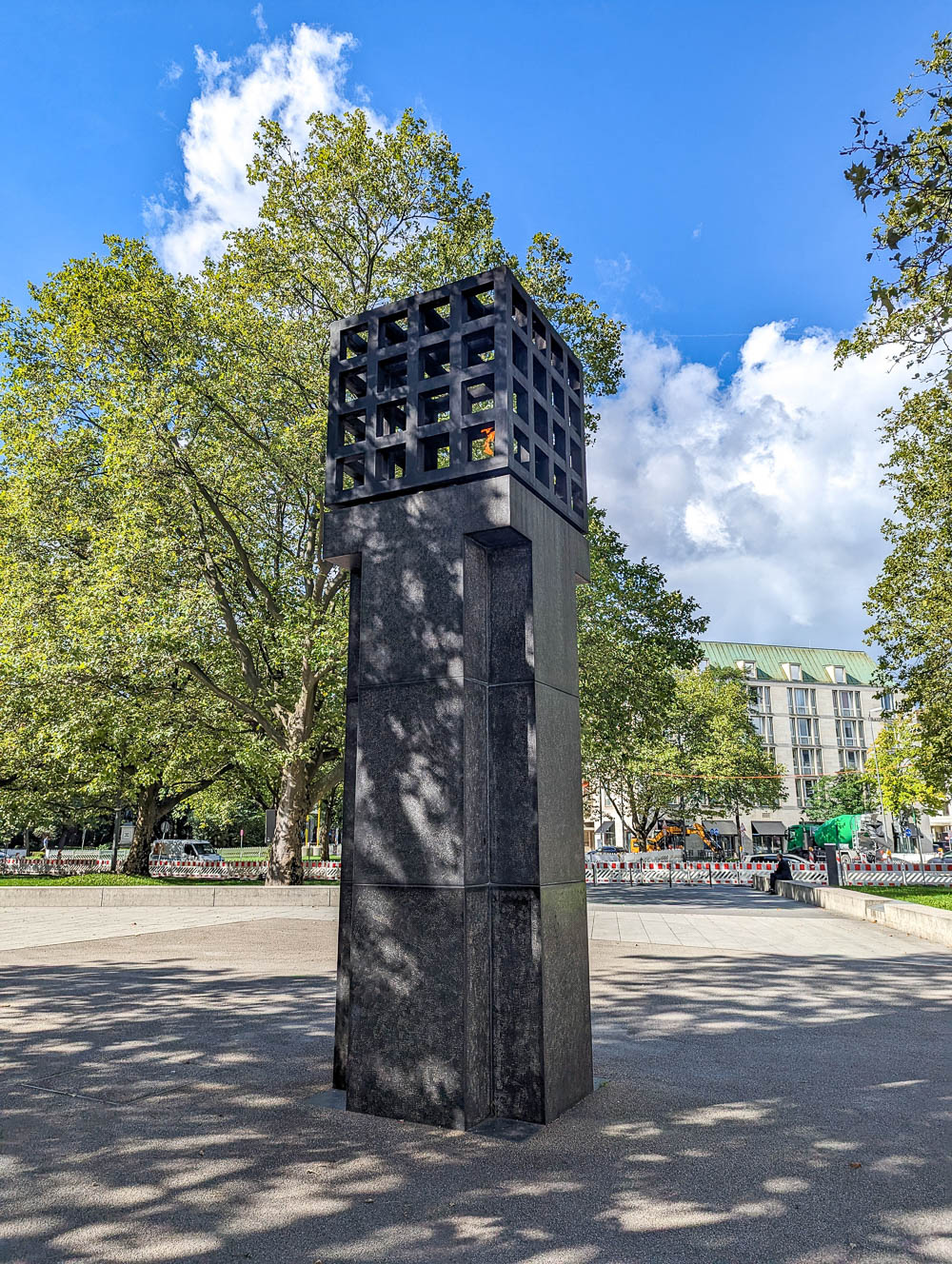
13. Monument to the Gays and Lesbians Persecuted Under the Nazi Regime
Munich’s Monument to the Gays and Lesbians Persecuted Under the Nazi Regime is another of the Munich WWII sites you’d probably never notice if I didn’t point it out to you. And that’s because this one’s hidden in plain site as a super abstract piece of artwork that reveals nothing about its purpose. Because, I presume, “art.” But I digress. (I know I say that a lot.)
You can find it painted on the ground at the location of the former “Schwarzfischer”—a gay bar that was raided on October 20, 1934. This raid marked the beginning of Nazi Germany’s systematic persecution of “homosexuals.” Look for the faded pastel-colored squares and rectangles under your feet. Yup, that’s it. Like others who’ve sought it out, I struggled to notice it at first.
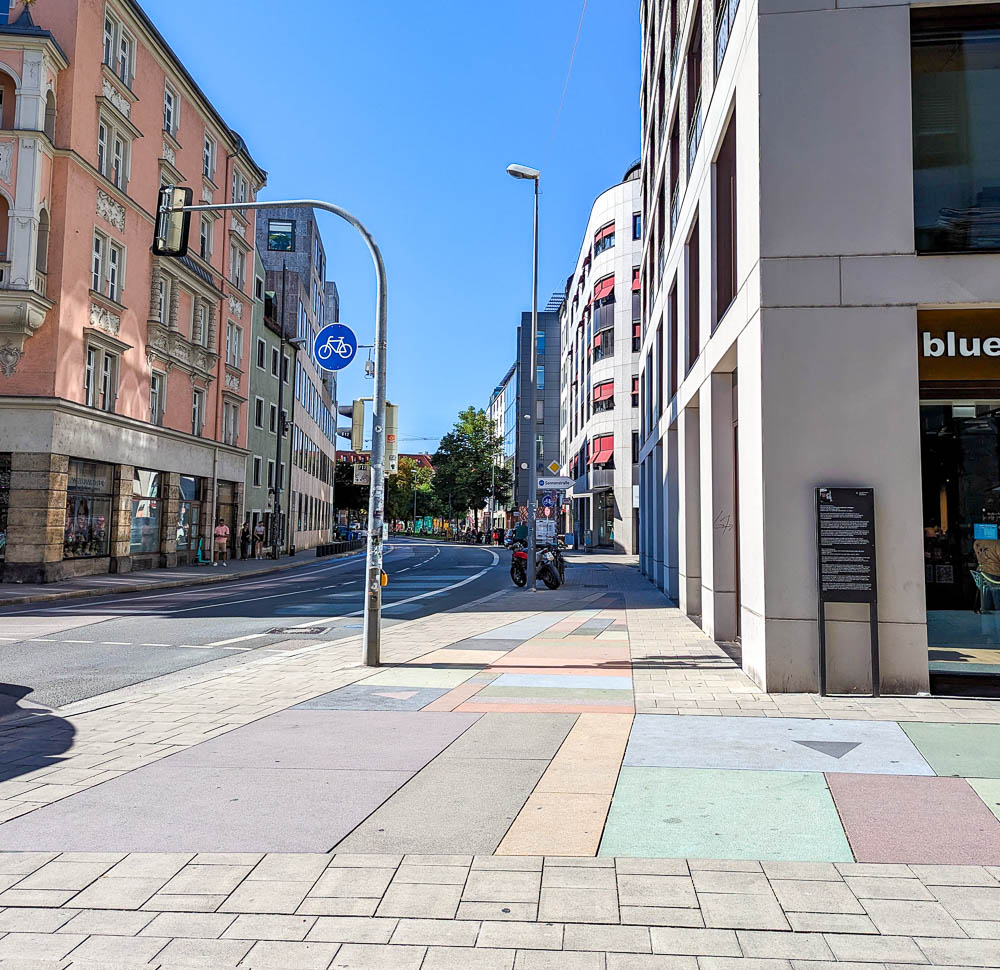
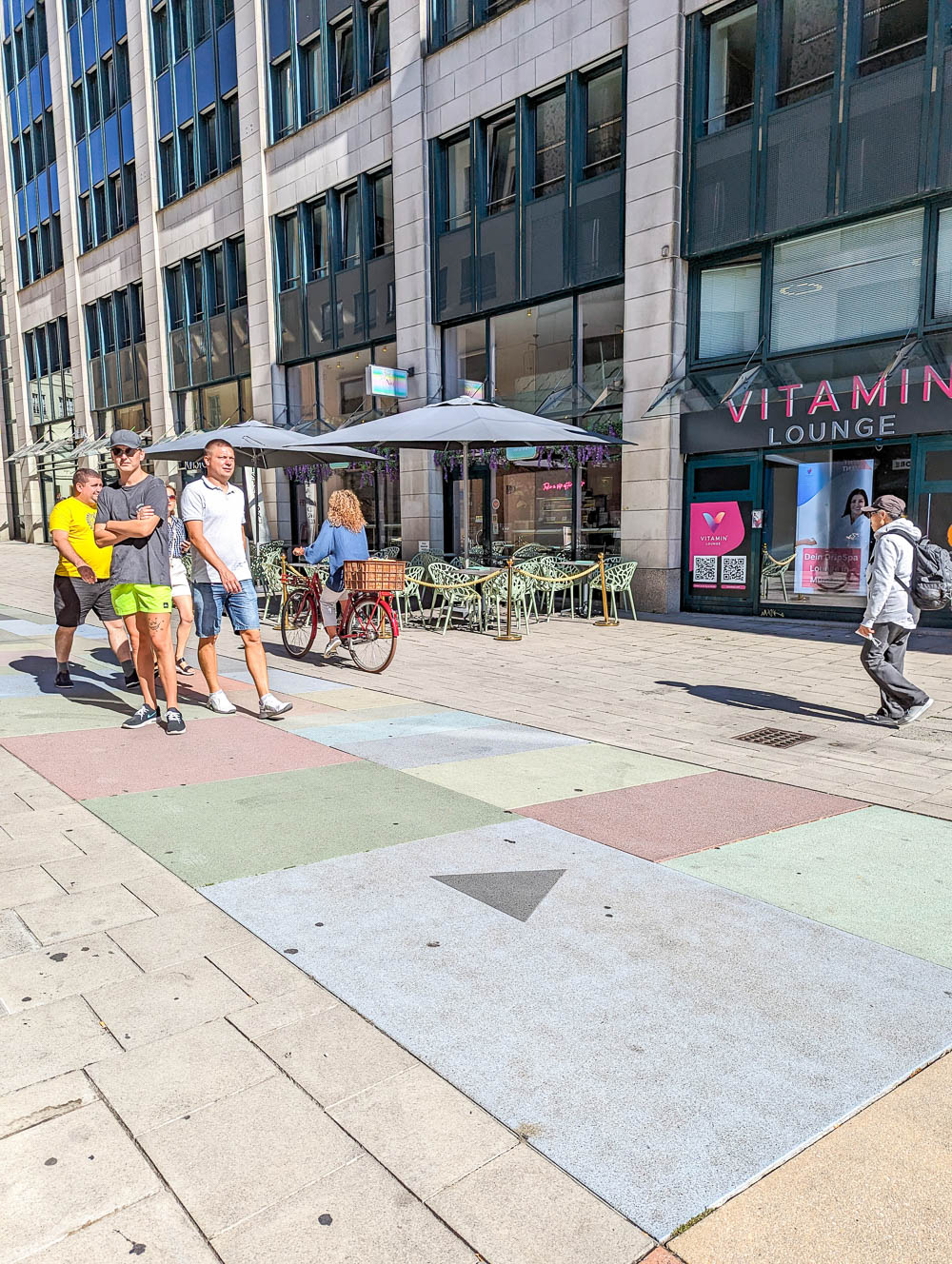
Among these colored squares are two triangles—one pink, one black. These represent the badges gay men (pink) and lesbians (black) were forced to wear in the concentration camps. (Thankfully, there’s a sign at the corner of the building that gives the memorial some context.)
If this topic interests you, definitely check out this article by Simone Stirner: “Memory in the Closet? Queer Memorials After National Socialism.”

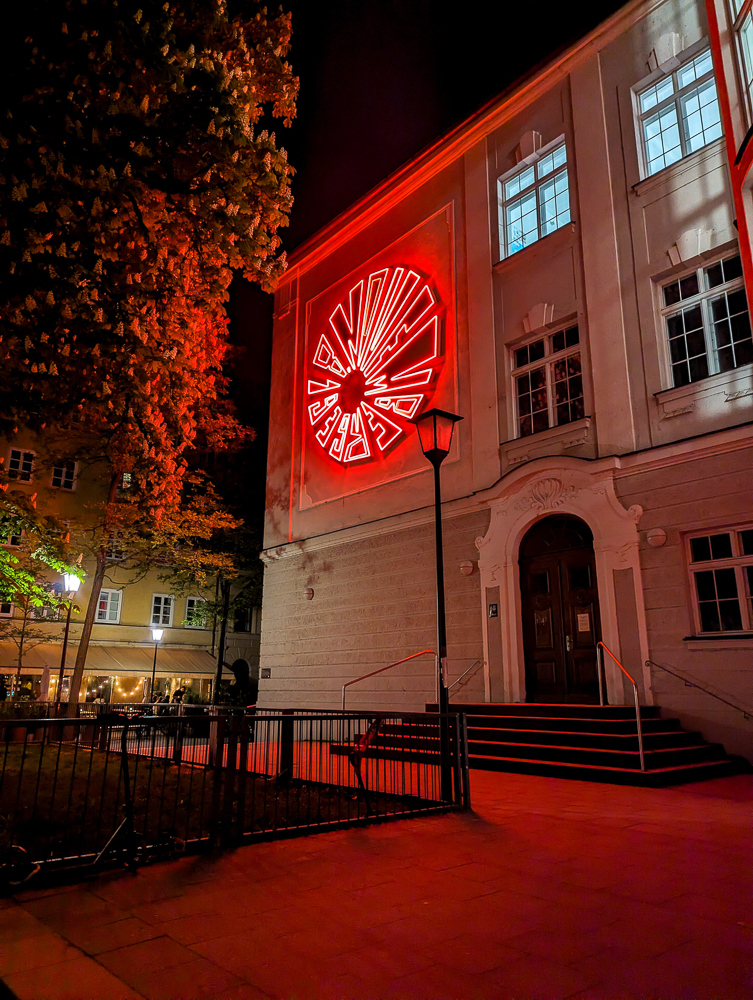
14. November 8, 1939 Memorial @ Georg Elser Platz
On the same block where Georg Elser once lived, you’ll find a lovely little square bearing his name. And in that square you’ll find the November 8, 1939 memorial high on the side of the local elementary school, commemorating the day Elser almost rid the world of Adolf Hitler.
By day the memorial blends in perfectly with the white exterior of the building. But at 9:20 pm every night (the time of the explosion), the memorial lights up in red neon. At 9:21, the lights go out, framing the single minute that could’ve radically changed history. A real “sliding doors” moment if there ever was one. Below the memorial (at eye level) is a small plaque summarizing the assassination attempt.
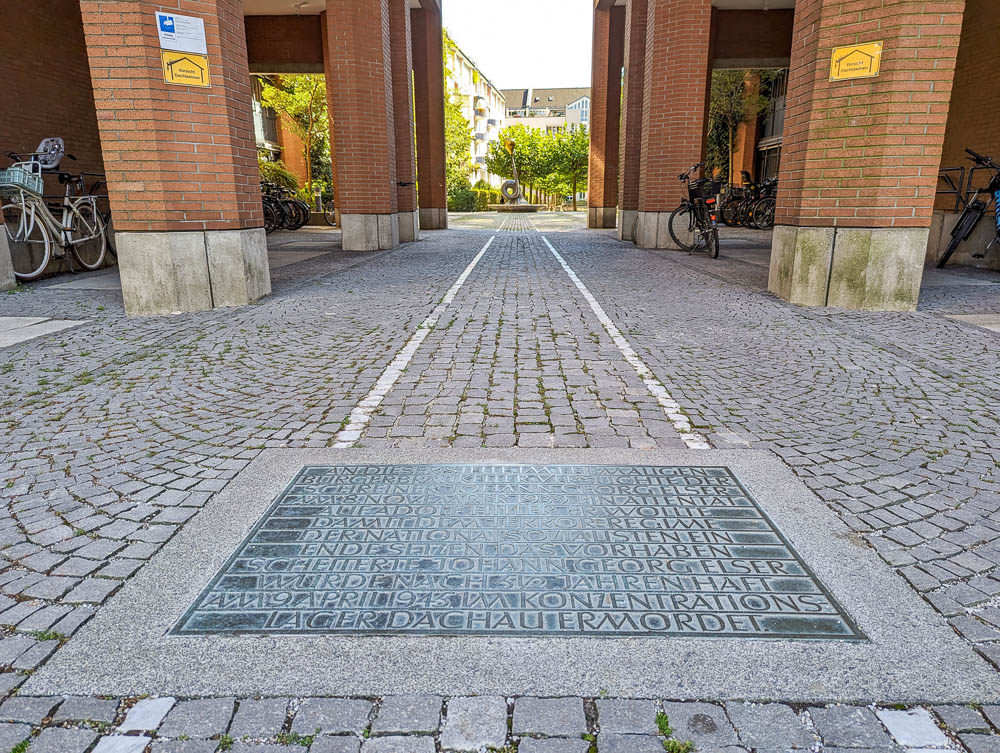
15. Georg Elser memorial @ the Bürgerbräukeller
At the location of the former Bürgerbräukeller, where Elser attempted to assassinate Hitler, you’ll find a memorial to him and this event. It reads (in German):
At this spot in the former Bürgerbräukeller, the carpenter Johann Georg Elser attempted an assassination on Adolf Hitler on November 8, 1939. He wanted to put an end to the terror regime of the National Socialists; the plan failed. Johann Georg Elser was murdered in the concentration camp Dachau on April 9, 1945 after 5 ½ years in prison.
Surviving the heavy damage it sustained from both Elser’s and the Allied bombings, the Bürgerbräukeller was leveled in 1979.
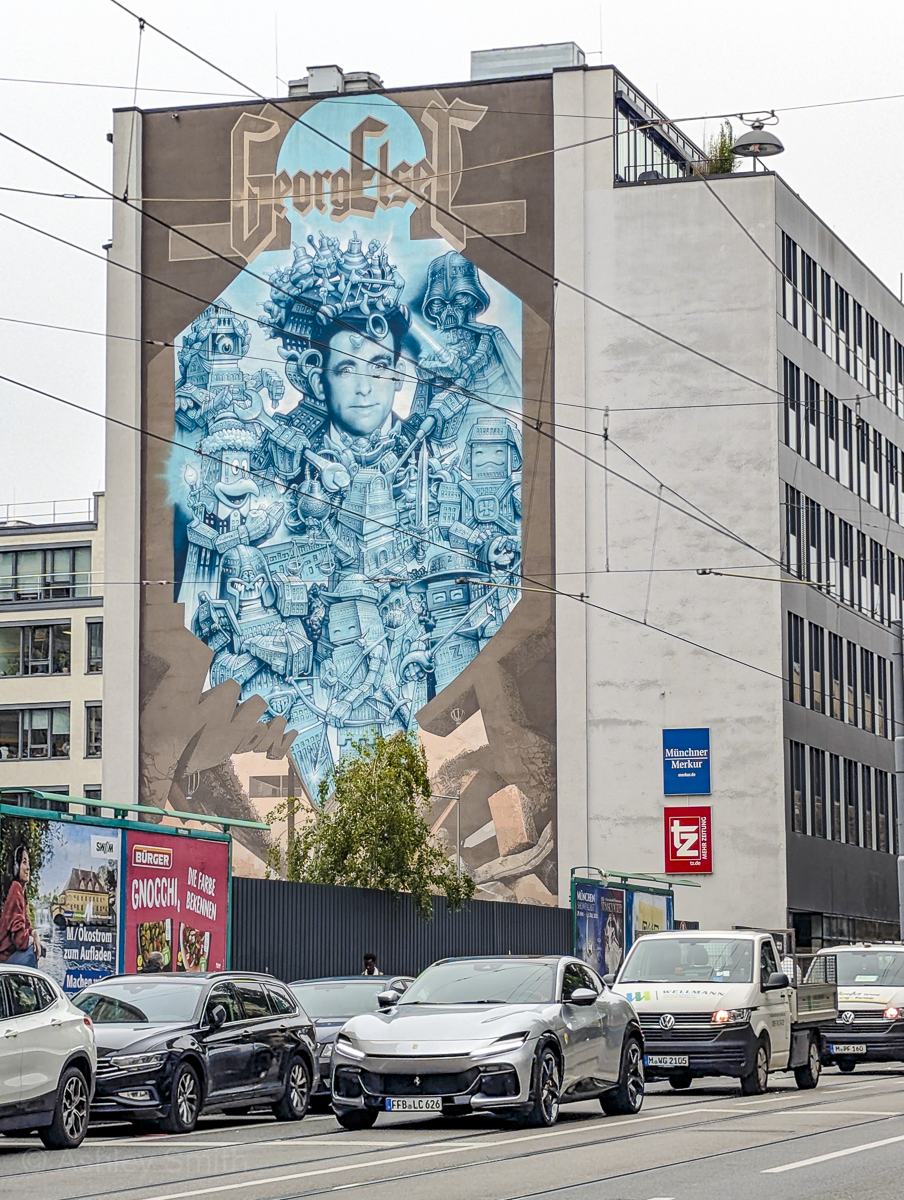
16. Georg Elser mural
Over on Bayerstraße, just a short walk from Munich’s Hauptbahnhof, you can see the largest mural in Munich, and it’s dedicated to Georg Elser.
Completed in 2017, this mural features Elser surrounded by such historical figures and pop culture characters like Julius Caesar, Darth Vader, and Robin Hood. It’s also loaded with symbolism, hidden artistic elements, and warnings for the future.

17. Jewish Memorial Tunnel
Connecting Munich’s (current) main synagogue—Ohel Jakob Synagogue—with the Jewish Community Center is a 105-foot-long tunnel referred to as the Corridor of Memory. The walls of this tunnel are lined with the names of 4,500 Jews from Munich who were murdered in the Holocaust.
For security reasons, this memorial isn’t open to the public but they do offer guided tours. Check this page for the registration requirements and a list of upcoming tour dates. (I wasn’t able to get in during my visit, but the nice man at the desk showed me a picture of the tunnel, below.)

18. Wounds of Memory
“Wounds of Memory” refers to a small collection of Munich WWII sites where you can still see bullet holes and shrapnel damage from the war. Artists Beate Passow and Andreas von Weizsäcker marked these spots using glass panels to both protect and help showcase the damage + the fact that “wounds” from WWII are still all around us.
The full collection is much larger, with installations in nine countries, but there are only three such sites in Munich:
- On the columns outside the Haus der Kunst (contemporary art museum)
- On the exterior brick wall of Ludwig-Maximillian University
- And on the horse statue in front of the Alte Pinakothek (European art museum)
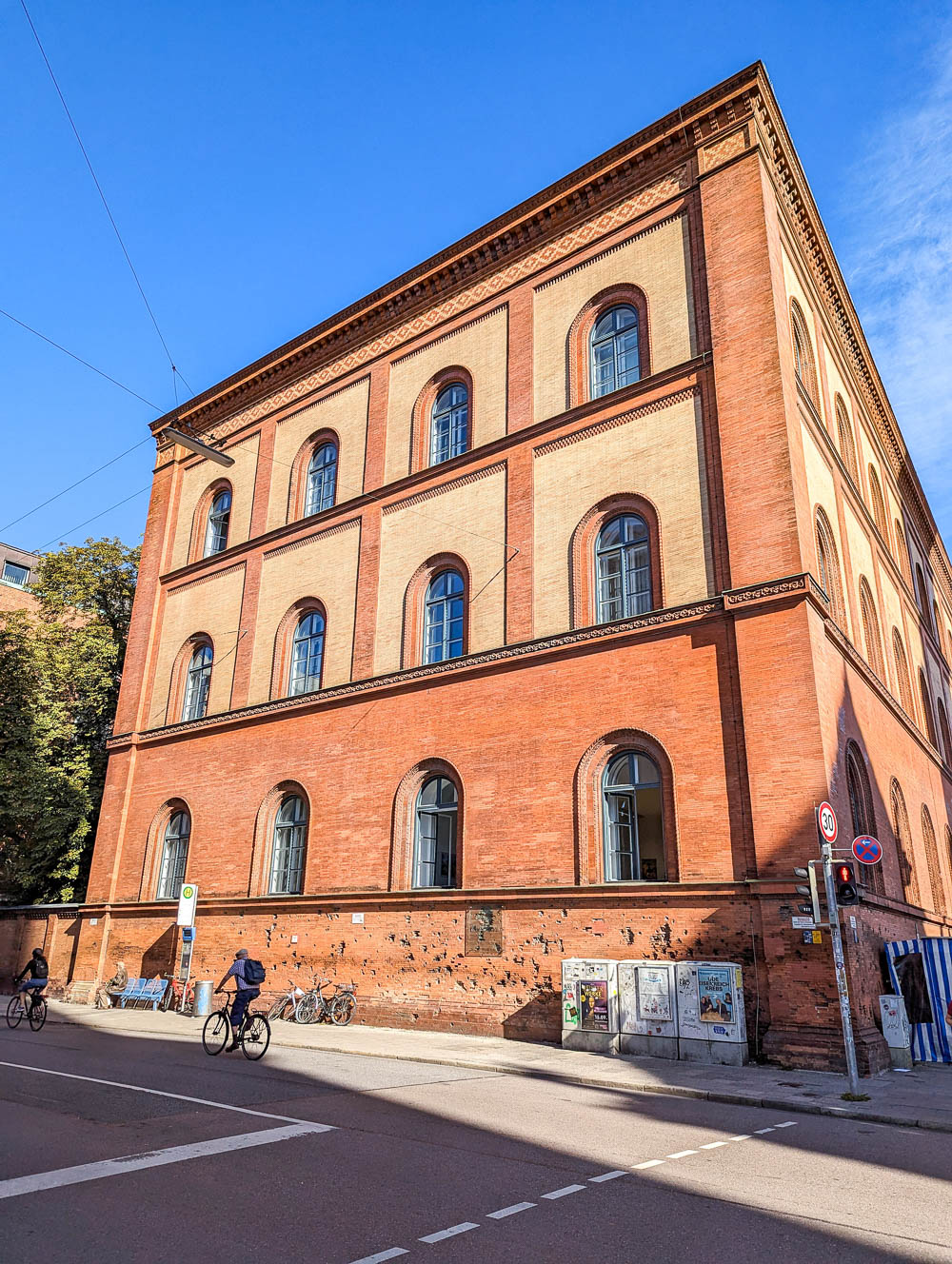
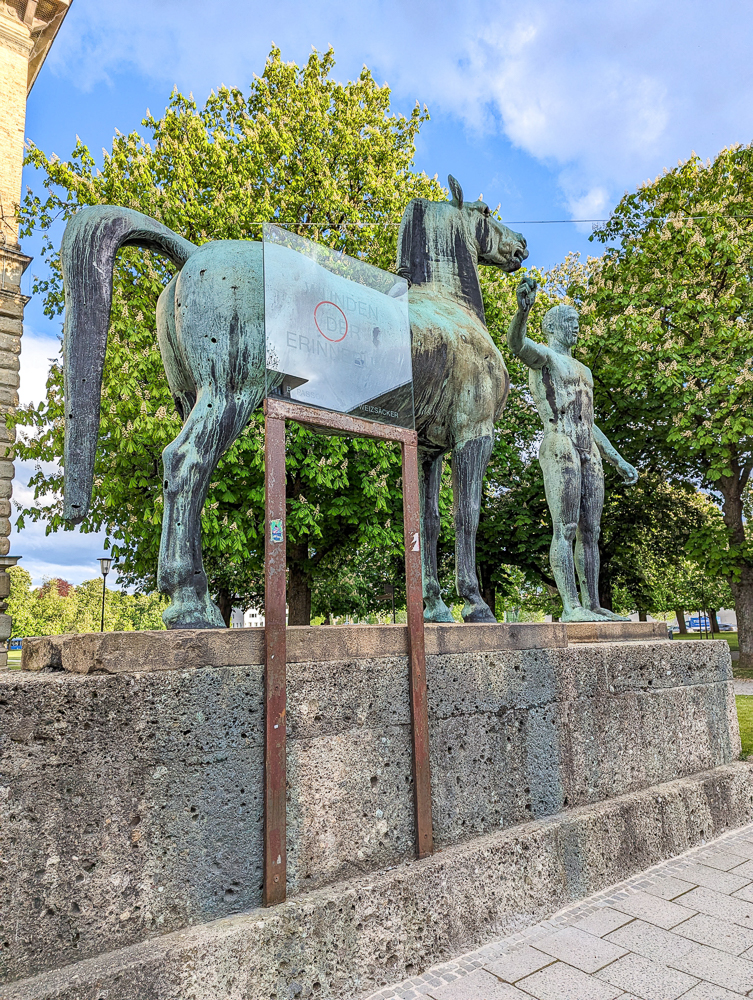
Munich WWII sites: Historic locations
Because so much happened here during the war, and despite numerous Allied bombings, there are still tons of historic Munich WWII sites you can see today. Here are a few of the many worth checking out:
19. Feldhernnhalle
As mentioned earlier, the Feldhernnhalle served as the Nazi’s main monument to their “martyrs.” The area also hosted rallies and other big events and was the starting point of Hitler’s Beer Hall Putsch.
Today, it’s a simple monument building with some statuary. (All Nazi iconography has been removed.) The area hosts festivals of a much different sort today but is otherwise just a large open plaza.
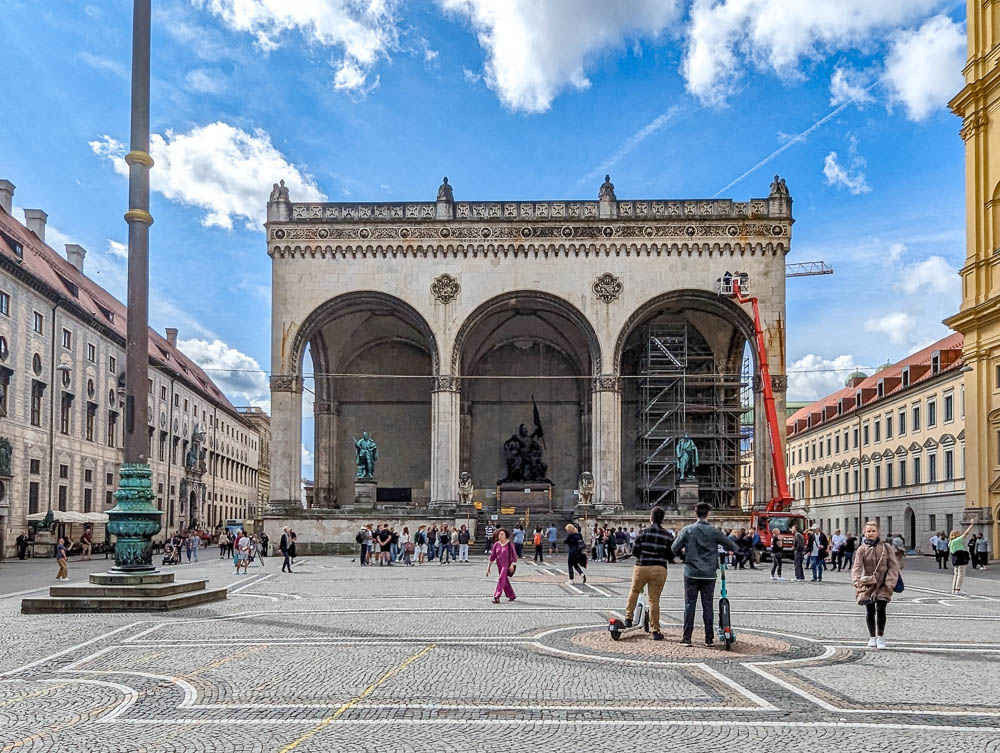
20. Königsplatz
Munich’s Königsplatz was another site where mass Nazi rallies and book burnings took place. Located near the Nazi Party headquarters (or vice versa rather), the area is marked by an expansive green surrounded by imposing neoclassical structures. Today, this is home to Munich’s gallery and museum quarter.

21. Munich Old Town Hall (Altes Rathaus)
You can’t miss Munich’s Old Town Hall – right there near the Marienplatz where you’re sure to visit. On November 9, 1938, it was here in the building’s ballroom where Joseph Goebbels delivered the speech that kickstarted Kristallnacht.
Though you can’t visit the ballroom (which is still a ballroom), you can find a plaque near the entrance that explains this part of its history. Look for it next to the door, under the arches.
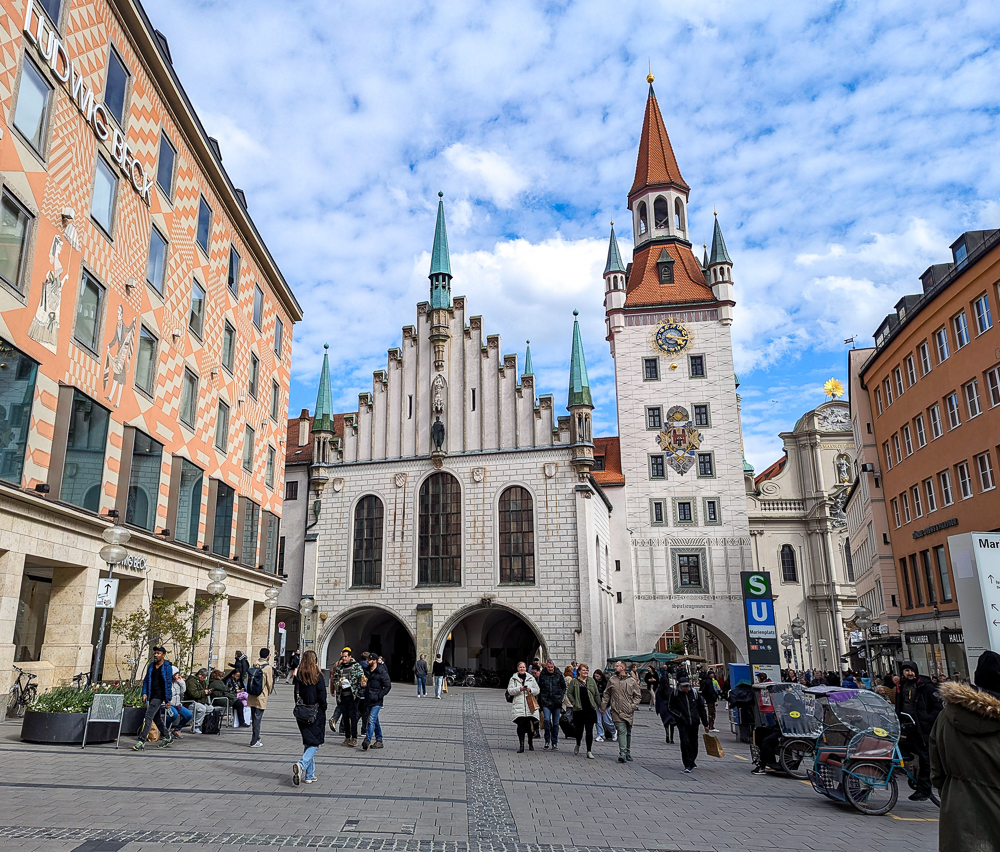
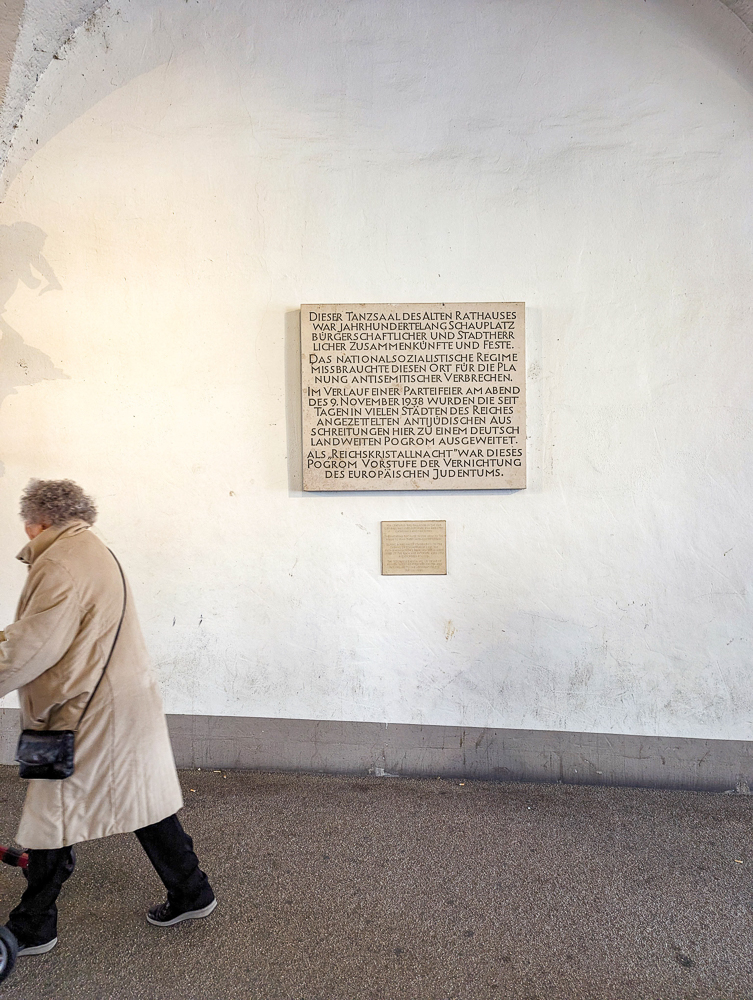
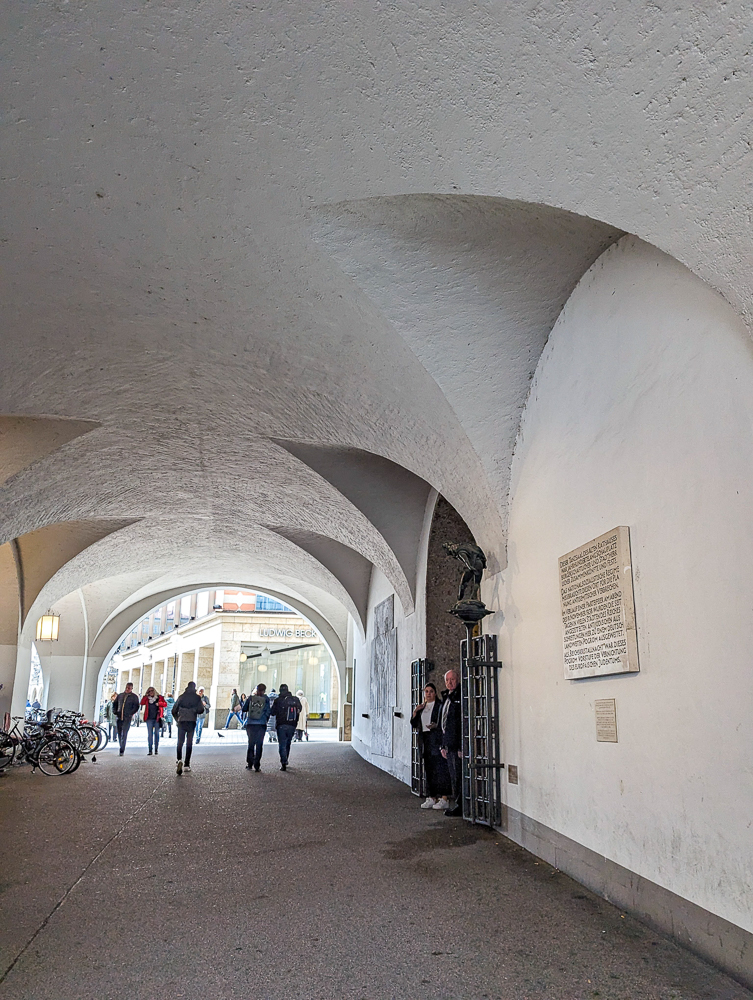
22. Golden Bar @ Haus der Kunst
While you’re at the Haus der Kunst checking out the Wounds of Memory, pop into the Golden Bar for a drink. The “House of German Art” was built in 1937 to be just that—a museum dedicated to German art—which is still is actually.
The name of the bar refers to the murals inside—painted with gold leaf. They depict the best of the world’s wines and spirits as well as several maps. The point? To make the Nazis appear worldly and to disguise the racist core of Nazi ideology. Nice try. Plan your visit here.
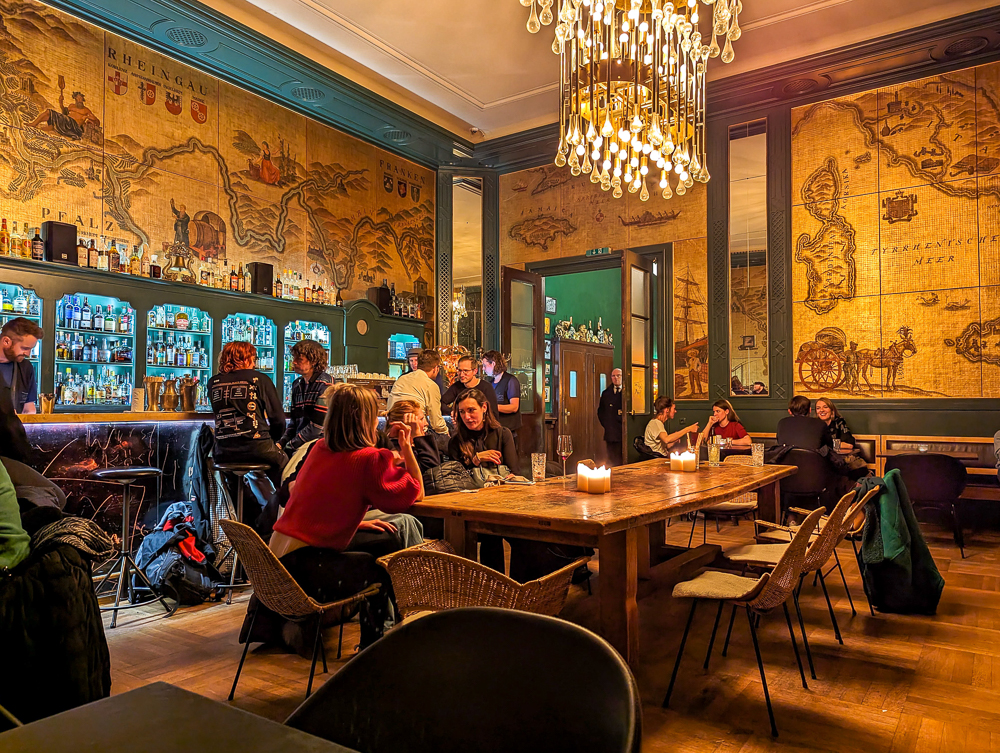
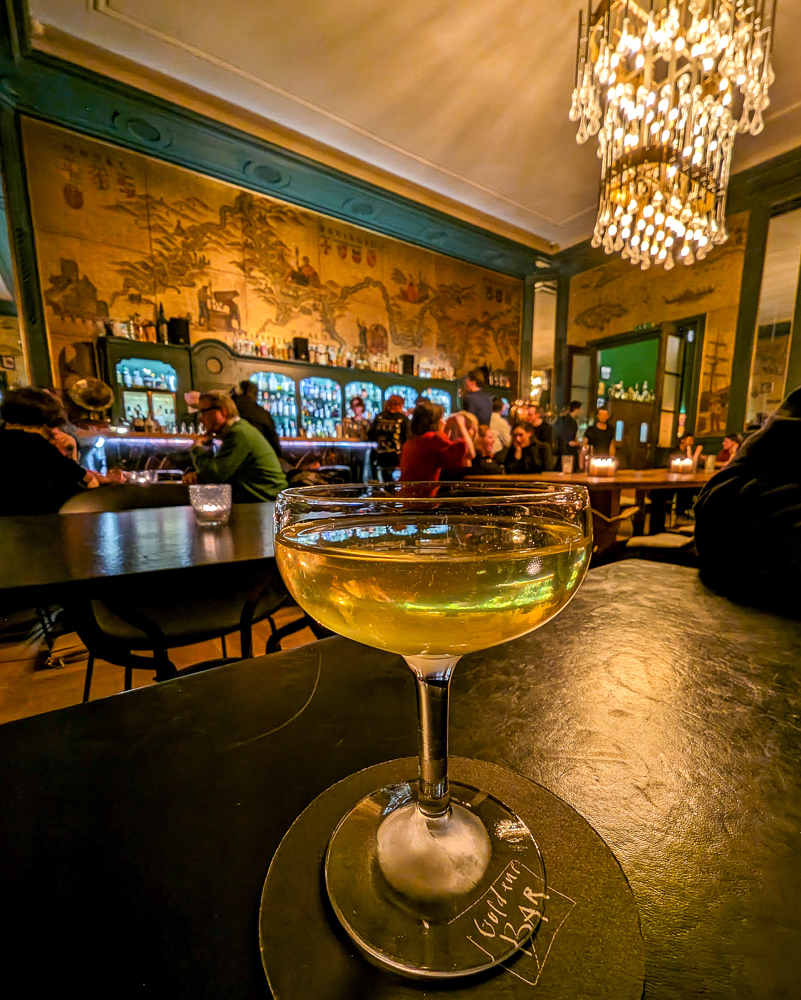
23. Sterneckerbräu
The Nazi Party evolved over time from a small meeting of men to, well, the nightmare it became. Back when it was just a fledgling fringe group, before its meetings were moved to the Bürgerbräukeller, the NSDAP gathered at the Sterneckerbräu. This is where Hitler was first introduced to them, by sheer dumb luck.
Though not a beer hall anymore, the building of the first Nazi Party headquarters still stands. Another on the list of hidden Munich WWII sites. Address: Tal 38A.
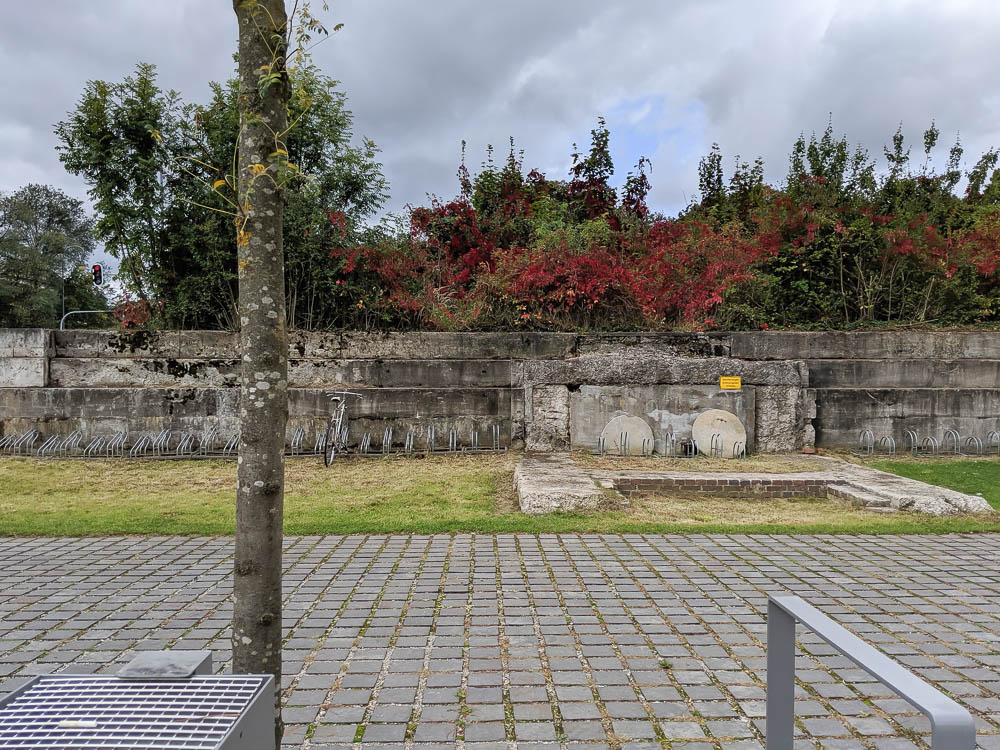
24. Hitler’s apartments
Hitler lived in a few different apartments during his long time in Munich. They all still stand just as they did over a hundred years ago but they’re all used for different purposes now. (Thankfully – can you imagine living there?)
Thierschstrasse 41
Hitler lived in an apartment at this address from May 1920 until October 1929. This is where he lived when he instigated the Beer Hall Putsch and where he returned after being released from prison entirely too soon. He was already the leader of the NSDAP at this point.
Prinzregentenplatz 16
From there, Hitler moved to an apartment at Prinzregentsplatz 16. He lived here full-time until January 1933 when he was appointed Chancellor, but kept the apartment for the rest of his life.
It was in this apartment that Hitler’s niece, whom he’d had an intimate relationship with and whom he’d basically taken prisoner, committed suicide in 1931. And it was also here where Hitler met with British PM Neville Chamberlain to further discuss, what would infamously become known as the “Munich Agreement” in 1938.
25. Führerbau
Located directly next to the NS-Documentation Center is the large building formerly referred to as the Führerbau (the Führer’s Building). Among countless other historically significant things that took place here in Hitler’s office building, most notably was the official signing of the Munich Agreement in 1938 by Hitler, British PM Neville Chamberlain, fascist dictator of Italy Benito Mussolini, and Édouard Daladier, Prime Minister of France.
The building today houses the University of Music and Performing Arts Munich. Address: Arcisstrasse 12
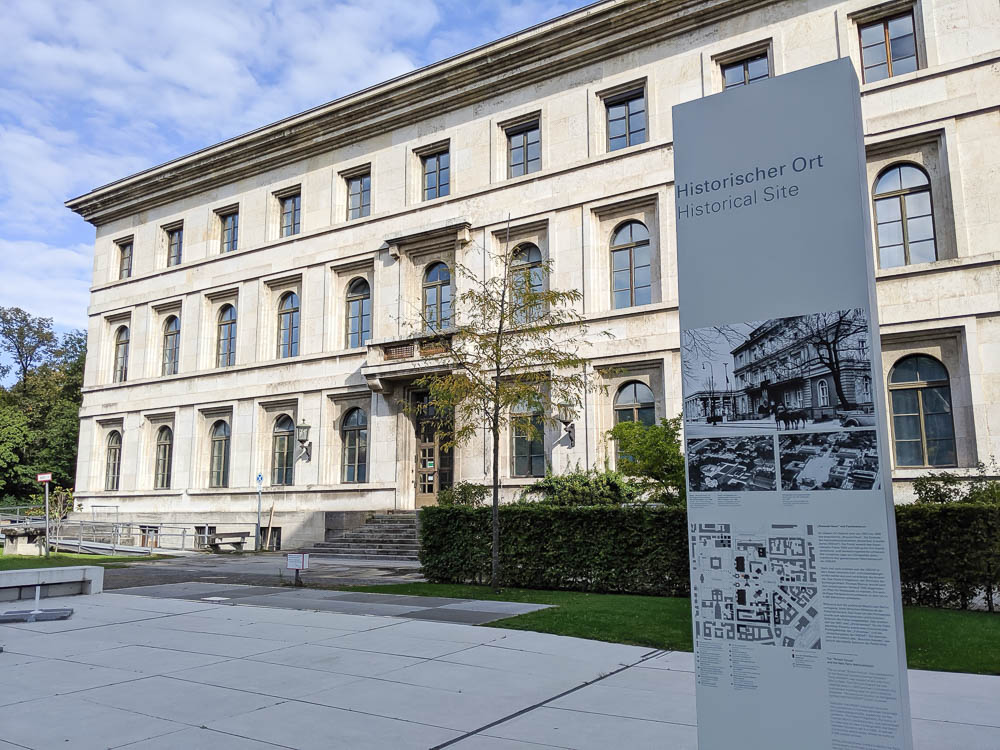
26. Early Nazi headquarters
Eventually, the NSDAP outgrew the Sterneckerbräu and another spot they used as their base after that. Before finally settling into the “Brown House” (where the NS-Documentation Center is now), the Nazi Party headquartered itself in the building at Schellingstraße 50.
This building still stands today, but what’s interesting about it is what you’ll see on the front. Above the main door still hangs the original Nazi Party eagle (head and swastika removed).
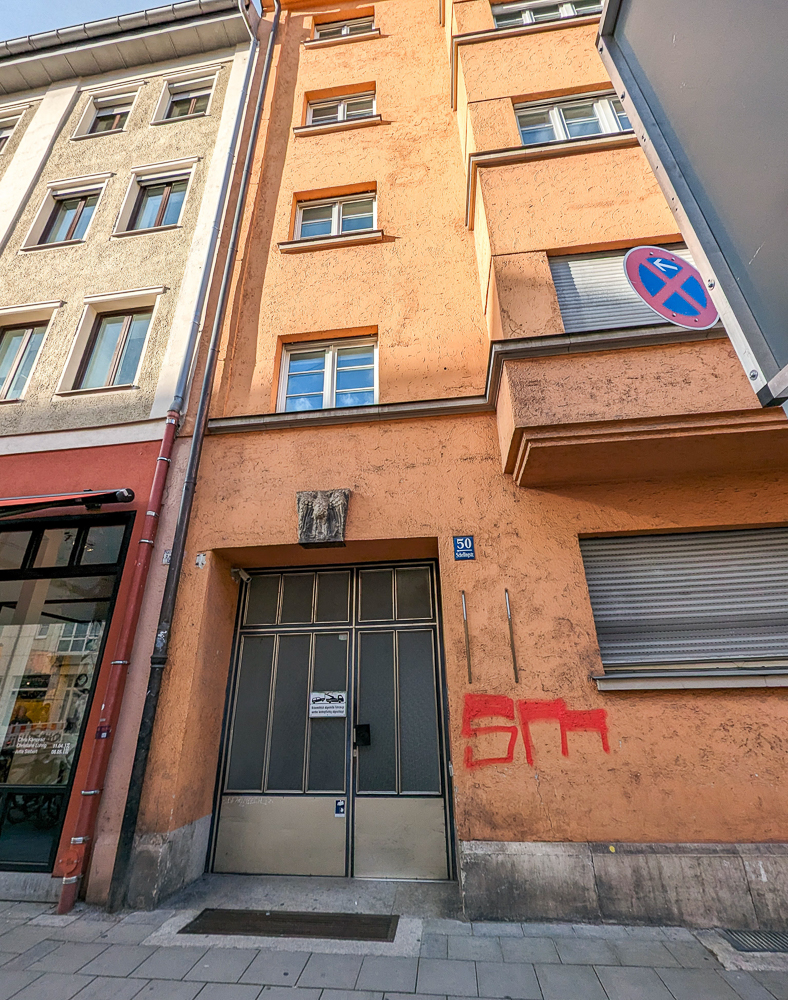
Best WWII day trips from Munich
If you’ve run through the list of Munich WWII sites and now you’re looking to get out of town for a bit, don’t miss the chance to visit these nearby destinations:
27. Dachau Concentration Camp memorial site
Just an hour away by train is the town of Dachau where you can visit the first Nazi concentration camp. Now a museum and memorial site, you can learn all about the Nazi camp system and visit buildings like a recreated bunker, the prison cells, administrative buildings, and, yes, the crematorium.
I can’t emphasize enough how much you need to visit this place while you’re in Munich, especially if you’ve never visited a concentration camp before. The trip is very easy to make and you will take something away from it.
- Admission: Free
- Visitor info here: kz-gedenkstaette-dachau.de
- More information here: My full guide to visiting Dachau Concentration Camp memorial site
- How to get here: See my full guide on how to get from Munich to Dachau here
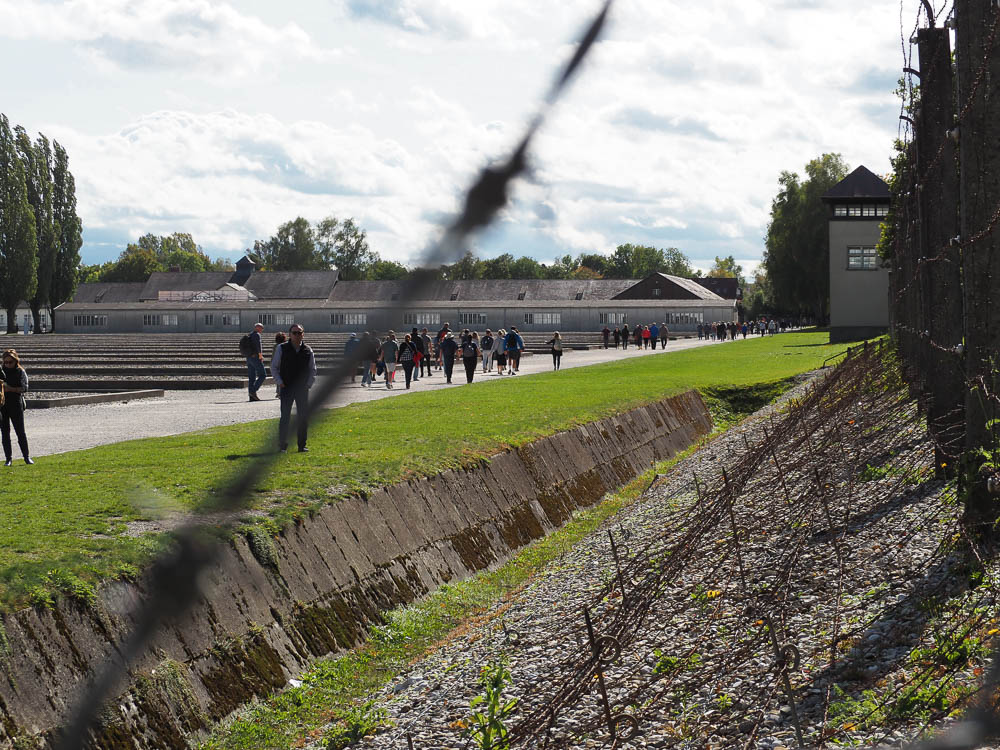
28. Eagle’s Nest
Another great day trip from the Munich WWII sites is to the Eagle’s Nest in Berchtesgaden. Hitler’s famous alpine retreat offers amazing views, a good lunch, and the chance to explore this historic building for yourself.
Getting there isn’t the most straightforward and the numerous train changes mean a big margin for error. SO, I’d recommend simply booking one of the day tours from Munich directly to the Eagle’s Nest. This is absolutely the easiest way to do this. Check out these options:
- From Munich: Guided Group Tour to Eagle’s Nest – Small group (8 max), guided tour, all 5-star reviews.
- Eagle’s Nest Day Tour from Munich – Your own guide, your own transportation, and they’ll even organize the bus tickets up the mountain for you.
And after you’ve booked it, be sure to read my post on what you need to know before visiting the Eagle’s Nest.
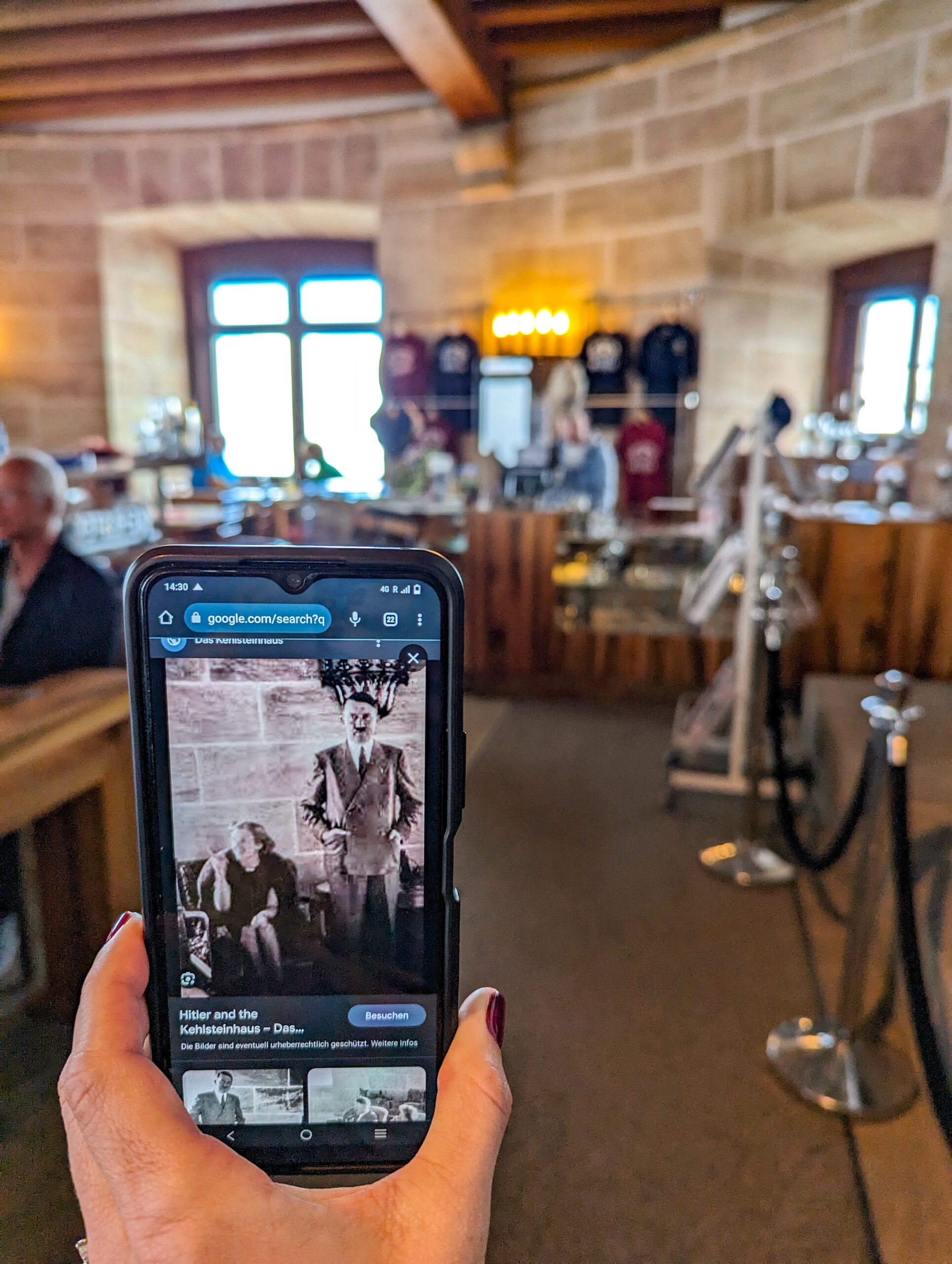
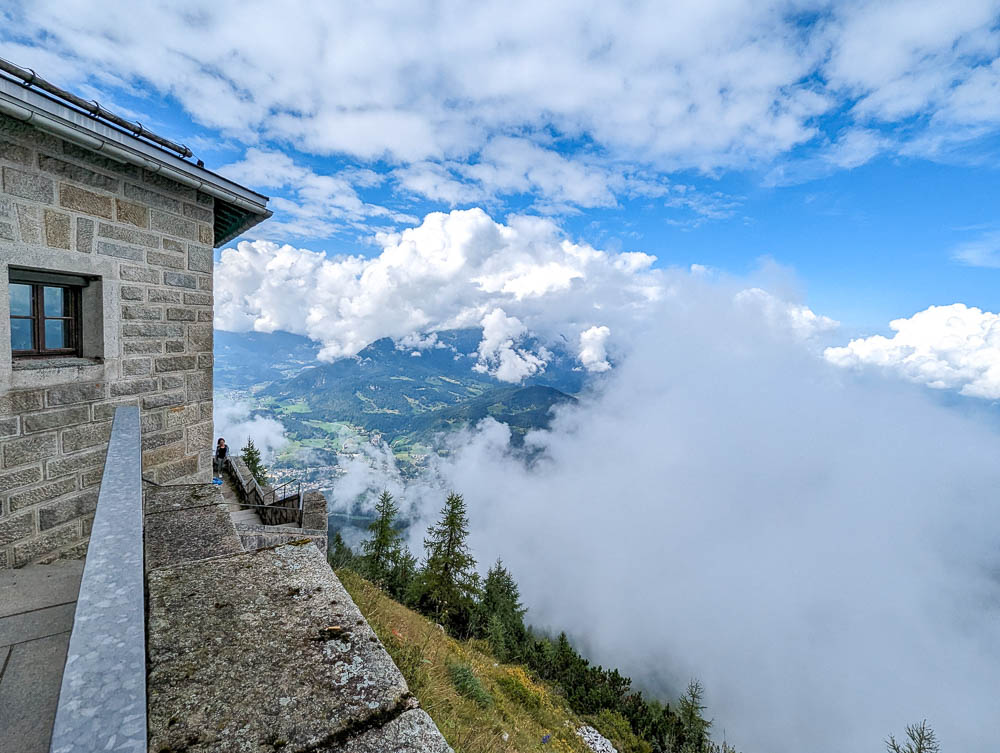
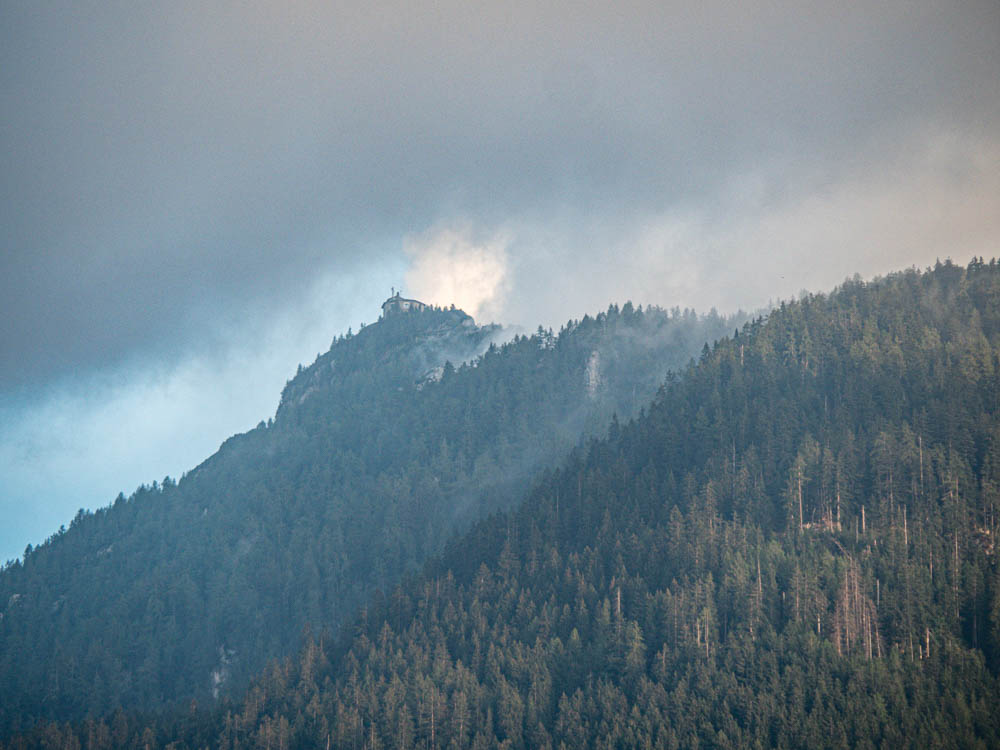
Tours of Munich WWII sites
If you’d prefer to visit the Munich WWII sites with the help of a guide, check out these popular Munich WWII guided tours:
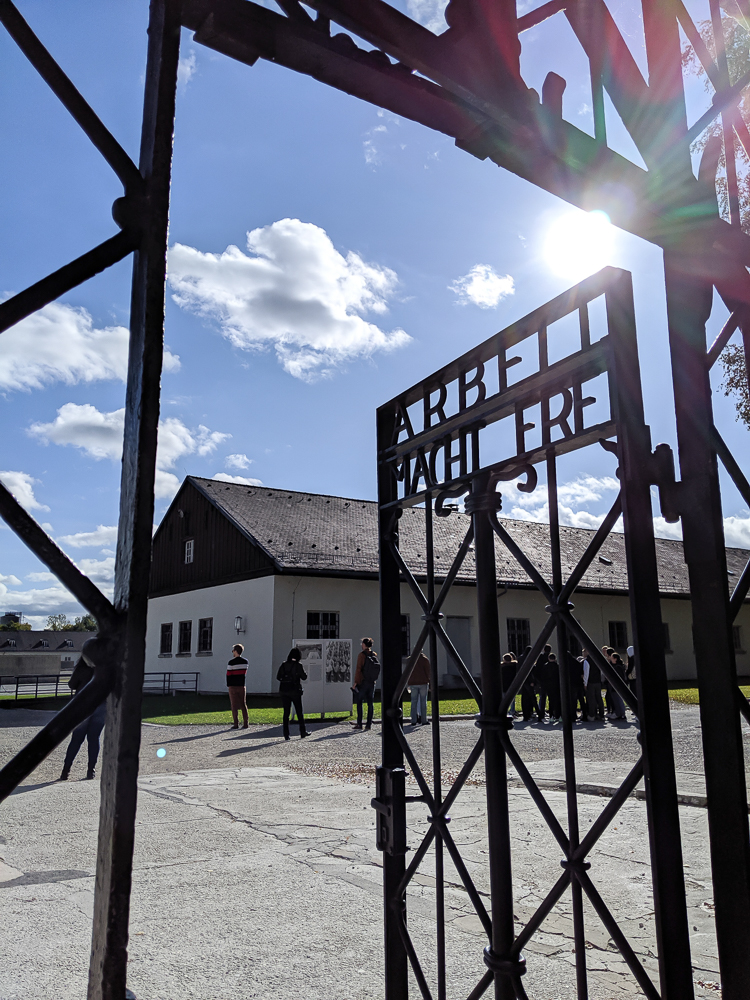
Munich WWII sites in books
To get a jump on learning about Munich’s WWII sites, pick up one (or all) of these books:
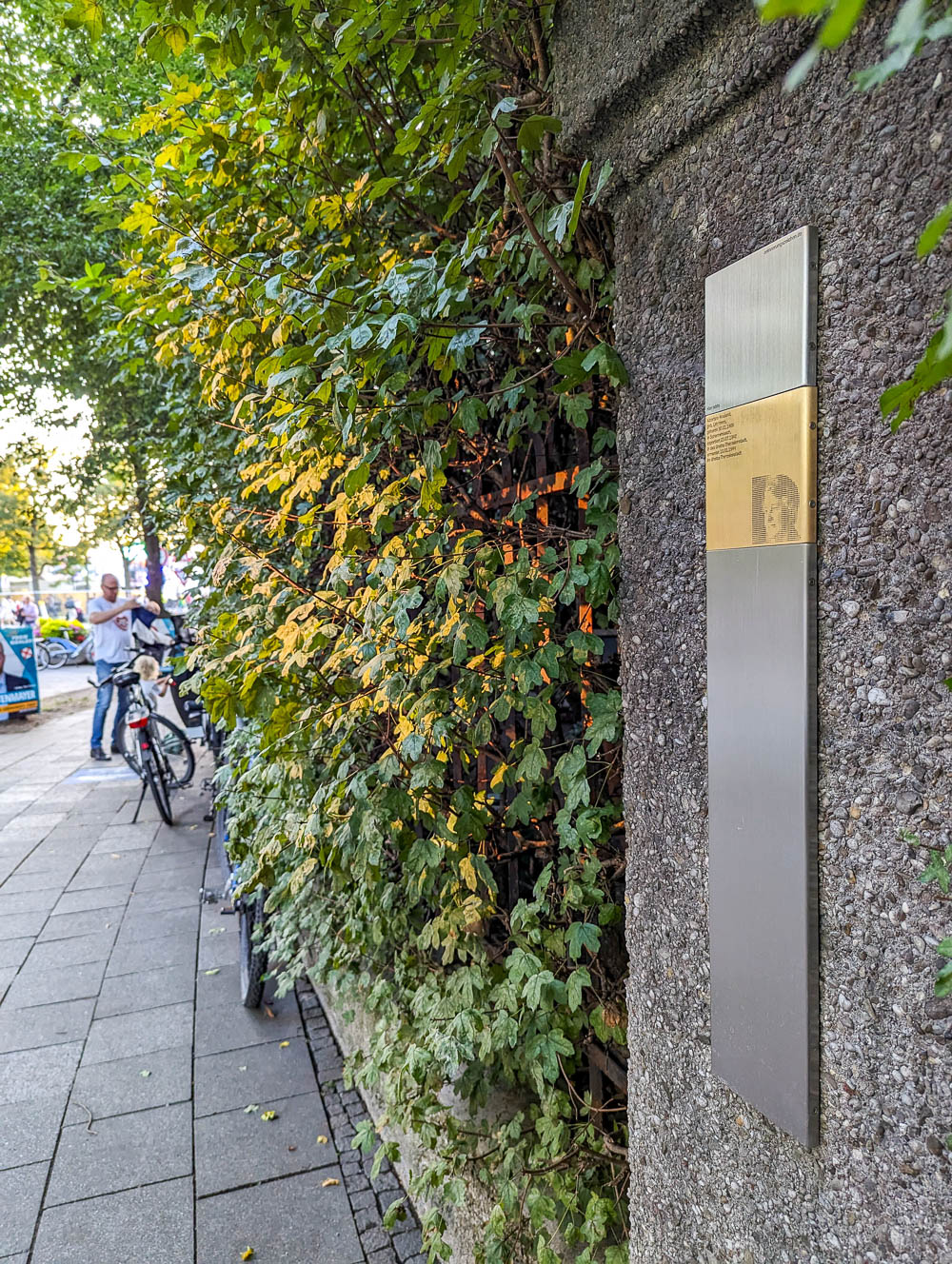
Munich WWII sites in movies
If you prefer to get your history in a more “entertaining” form, check out these great movies:

Resources for visiting the Munich WWII sites
- Hotels: Find great places to stay in Munich here on Booking.com (my favorite). Hotels.com and Expedia often have good deals too. VRBO is best for rental properties.
- Rental cars: Check out the best rental car deals here.
- For great local tours and activities, check out all the options from Viator and Get Your Guide.
- Don’t forget a Germany guidebook and this must-have Germany customs and culture guide!
- Want more? See all my Germany posts here.
Like this post? Have questions about the Munich WWII sites? Let me know in the comments below. Have a great time in Germany!

Save this info, pin these images:

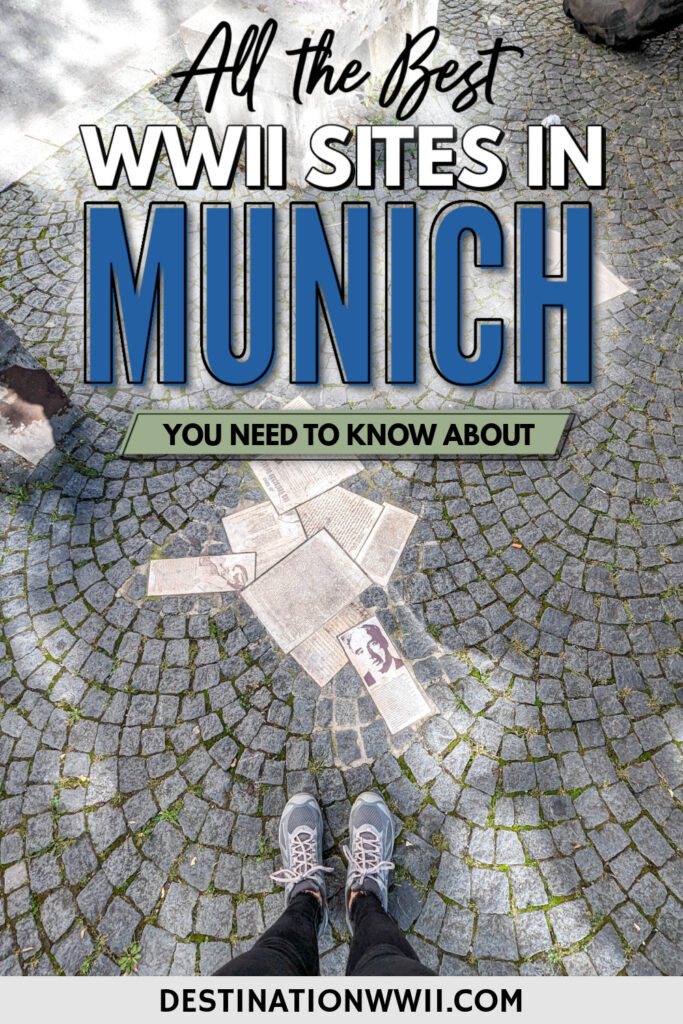
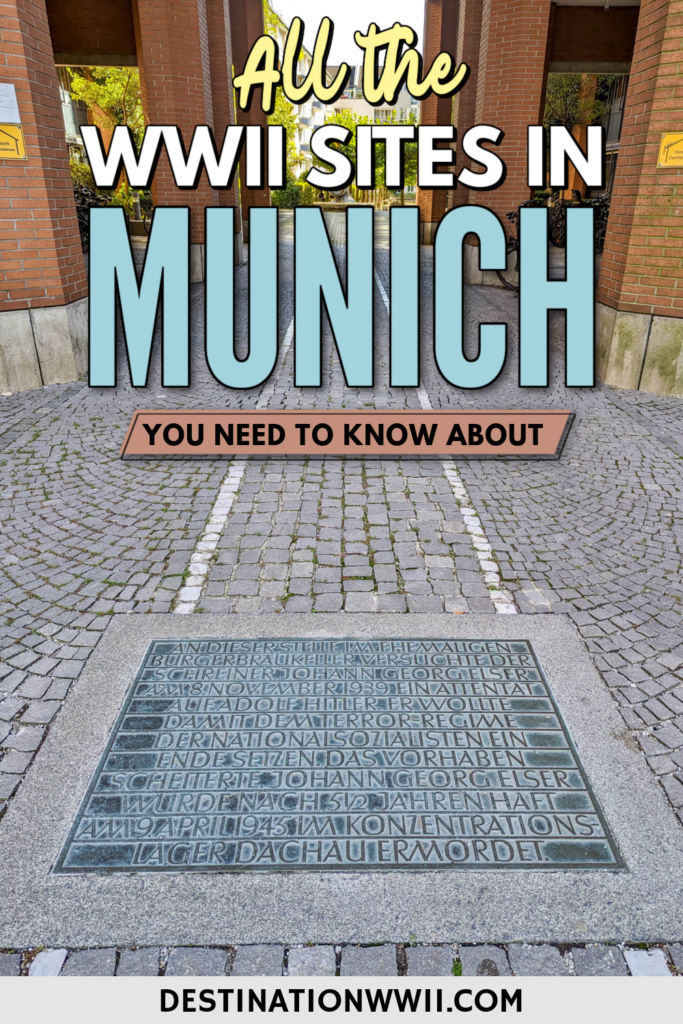
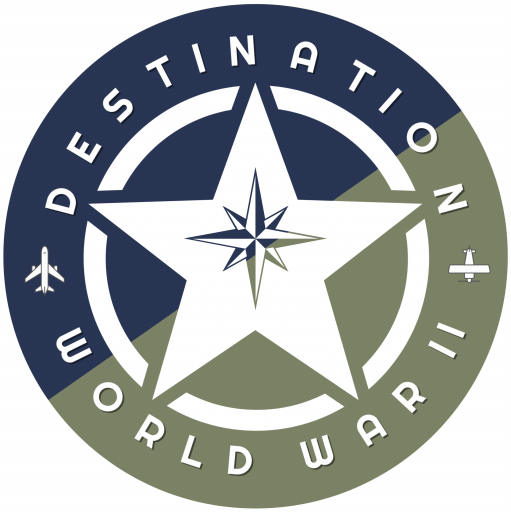
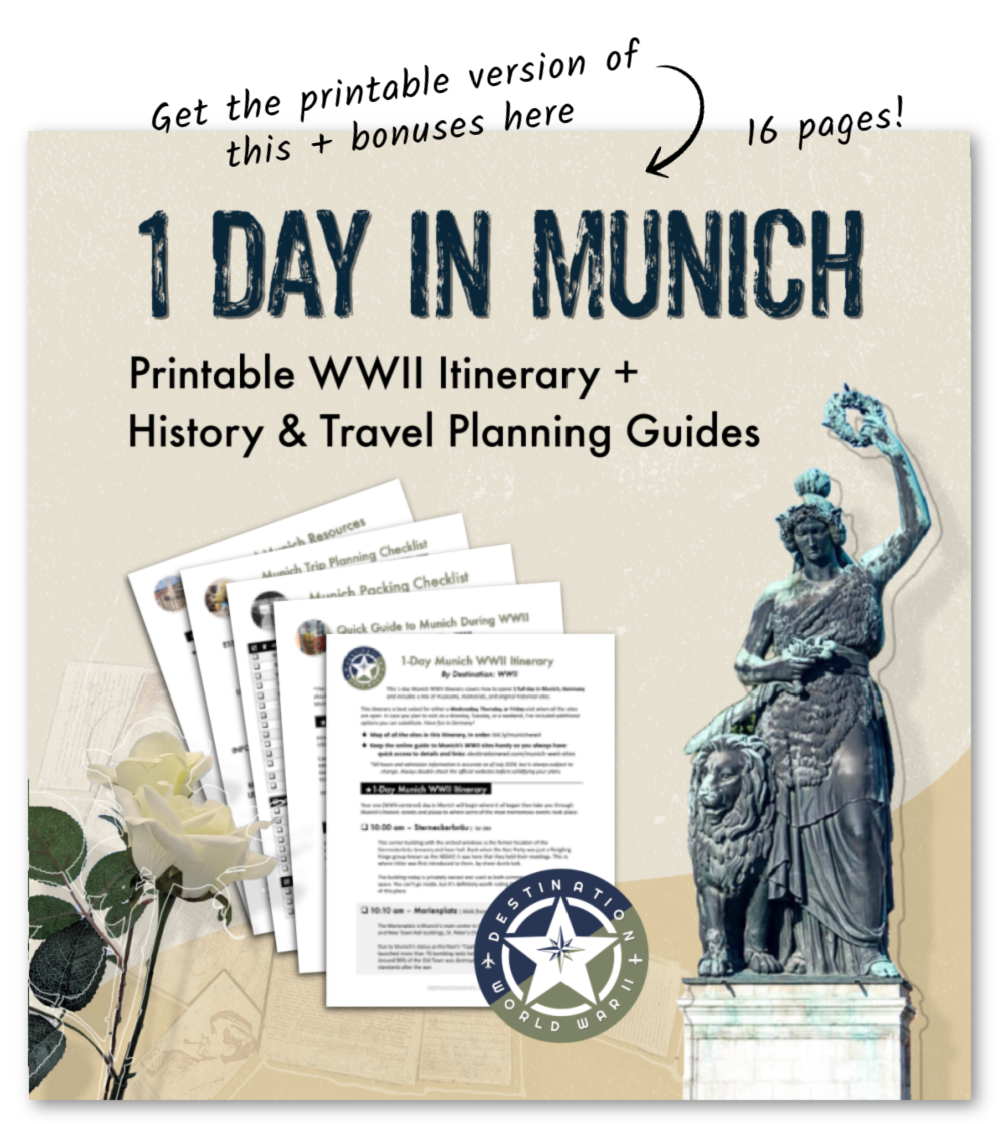
Your site about Munich and its WW II history is the best I have ever seen!
It is very well written and structured, and the many pictures add greatly to the already excellent texts.
I have marked your site as my go-to for planning my future visits to Munich.
I lived in Oberammergau (site of the “Messerschmitt Caves”) as a pre-teen and teen for 4 years (1960-64) when my dad was stationed there with the US army.
At that time I explored the few WWII sites in O’gau (a couple of bomb shelters, the caves behind the kaserne carved into the Laber mountain (still with worker lockers remaining inside), and a machine gun nest on the Laber mountain), as well as wandered with my friends through the local scenery looking for relics (I did find a WWII mortar round, and my friends found helmets and a machine gun…).
While in O’gau, I attended Garmisch American Junior High and also 1 year in Munich American High School.
Since then, I have been able to visit O’gau (other lesser known German locations, and always Munich) many, many times through the years. When in Munich I always stay in the altstadt, and visit, and revisit, many of the WWII sites (and you have shown me many that I still need to visit!!); the last few times I decided to stay in the rebuilt Hotel Torbräu.
Thank you again for creating this terrific site!
Thank you so much, Charles! That means so much to me. There’s definitely a lot to see in Munich so I’m glad I can introduce you to some new stuff. 🙂
Thank you so much for this post. I´m about to book my first ever trip to Munich with my adult son and will want to concentrate on Nazi history while there. All this information in one place, like this post, is invaluable.
I’m so happy you found it useful, Sami! I hope you and your son have a great time in Munich.
The penny dropped on an overnight business trip to Munich from London that this is where much of the Nazi movement took place – I just never knew how much till now. The historical parallels now are quite disturbing across the world, making this more resonant than ever. I’d like to return to visit these sites, memorials and museums in what is a gorgeous city for everyone. As a side note, at many German flea markets in the former eastern bloc, particularly in Poland, you’ll find paraphernalia from this era, most notably the menorah of Jewish families who’d never have voluntarily parted with them. I have one as an anonymous tip of the hat to whomever was lost. Thank you so much for your painstaking research.
Thank you, Bruce! And yes I don’t think many people know that Munich was where it all started actually. And what an interesting little tidbit.
Thanks so much for all of this information! My husband and I are planning a trip there in 2025. We will be following lots of your advice…you have saved us hours of research.
That’s great, Gigi! I’m so happy I could help. I hope you have a great time on your trip!
Ashley, thank you for all the information you provide on WWII Sites and history.
It’s interesting that you said your “obsession” started after your trip to Dachau. Mine did too. My parents took my sister and I there around “79” when I was about 10 years old.
I’ve been lucky enough to get stationed in Germany 3 times since and have traveled around Belgium, Luxembourg, Nederlands, Poland and to Czechia visiting historical places.
I now live back in Alabama and wait patiently for my next adventure.
Thank you for your posts.
Paddee
Thank you so much for your reply, Paddee. I love to see that you have visited so many worthwhile places!
A wealth of information and knowledge. I visited Munich 14 years ago and did not see any of these places except for Dachau. I have been looking at going back in the near future.
Thank you Sally! I hope you get to see much more on your next visit.
very interesting website
Thank you, Judith!